- Cover Letter Tips

Should You Combine Your Cover Letter and Resume into One Document?

The internet has impacted virtually every area of life, including the job search process. Gone are the days when a job seeker would simply hand an employer a cover letter and resume in paper form. Today, more companies than ever accept digital copies of those job search documents.
In fact, many companies and employers now only accept emailed digital cover letters and resumes so they can make use of applicant tracking systems (ATS). Unfortunately, there’s been little effort to standardize submission processes, and that can make it a little confusing for the average job seeker.
For example, how should you submit your emailed resume and cover letter? Should you send them separately or combine them into one document? In this post, we’ll examine both options and offer the advice you need to make the best decision.
What’s the difference between a cover letter and resume?
Before you decide whether to combine your cover letter and resume into one document, it is helpful to make sure that you fully understand each of these important tools. The fact is that each of these documents has its own role to play in the job search process, and they have some major differences:
Each of these documents serves a distinct purpose in the job search process. Resumes are designed to provide an employer with an easy way to quickly assess your qualifications. The main purpose of a cover letter is to help the employer understand your motivations, goals, and personality. Both are important documents, but they are not interchangeable.
Your cover letter should be a targeted document that focuses on your qualifications for a specific job role. It should contain information about why you are the best candidate for the position and what you hope to achieve for the employer if you are hired. Your resume is more of a marketing tool that highlights your skills, relevant work experience , and educational qualifications in an easily digested summarized format.
Structure and format
These two documents also have dramatically different structures and formats . Your resume will be divided into specific sections for easier consumption and will include bullet point lists of relevant skills and achievements. Cover letters look more like any other written communication, conveying your message in full sentences and paragraphs.
Cover letter and resume: to combine or not to combine?
Let’s get right to the main question here: should you combine your cover letter and resume into one document? As a general rule, you should try to avoid it wherever possible. Since resumes and cover letters serve two very different roles in the job search process, they should be treated as separate documents. The only time you should even consider combining these two documents is when the company has instructed you to do so.
Review the instructions
Whenever possible, it’s a good idea to get the submission guidelines for the position straight from the source. That means asking the company’s hiring manager how your resume and cover letter should be sent. If there are clear instructions, it’s important to follow them to the letter to maximize your chances of receiving the right type of attention. On those rare occasions when a company wants a combined document, the job posting will usually include that instruction.
Why you should not combine these two documents
In most instances, however, you will discover that the instructions are vague. Perhaps the only instruction is that your resume must be emailed. If that’s the case, then you should always choose to leave these two documents as separate files. There are several very good reasons to do so:
If you include these two tools in one document, applicant tracking systems may reject it. That can happen if the ATS mistakes your cover letter for a resume and assesses it based on its rules for resume approval.
Hiring managers often want to go directly to your resume to review your qualifications. If your cover letter is part of that document, it could be a distraction that frustrates your reader.
Your cover letter and resume serve different purposes. Keeping them separate helps to ensure that each document receives the attention it deserves.
What if employers request that your cover letter and resume be combined?
As we noted above, there may be times when a specific employer requests that a resume and cover letter be sent as one document. Obviously, that request should be honored if you want to be considered for an interview. The important thing then is to ensure that you combine them properly. The following tips can help:
Decide which document you want the employer to see first
Since the cover letter serves as your introduction, there is a case to be made for putting it in the front of the resume. If you want to make sure that the ATS scores your resume properly, however, you may want to put the resume at the beginning of the document. That can also help hiring managers quickly access your qualifications.
Create a new document
Make sure that you create an entirely new document for your combined file. That will enable you to keep them separate for other companies and submissions. Then copy and paste your resume and cover letter into this new document. Be sure to save the file with an appropriate file name. For example: JohnSmithResumeCoverLetter.docx or JohnSmithResumeCoverLetter.pdf.
Use proper formatting
When you paste each document into your combined file, make sure that you retain the original formatting. Also, be sure to include a page break at the end of the first document so that the next document begins on a fresh page.
Submit the combined file
Once you have your new combined file, submit it to the company. If the online job posting includes submission instructions, follow them to the letter. Otherwise, simply send it to the appropriate email address.
How to email your cover letter and resume
When emailing your cover letter and resume, either include the cover letter as an attachment or copy and paste its text into the email message. Don’t do both.
It is generally recommended that you submit both the resume and cover letter as file attachments rather than having any part of them in the body of your email message. What you can include in the email text is confirmation that you have attached the resume and cover letter files.
Of course, you also need to decide whether you want to submit a Word document or a PDF file. Once again, review the job board instructions to see what the company is requesting. If there is no specific option listed, then the best thing to do is to submit each document in a Word file.
Sample cover letter and resume template
Below, you will find a resume and cover letter template that you can use to ensure that your job search documents contain the information that employers want to see. You can use these templates to guide you as you create your own cover letter and resume:
Resume template
[Your first and last name]
[Your Phone number]
[Your Email address]
Professional Summary
[No more than three sentences highlighting your qualifications, experience, and achievements.]
Core Competencies
[Bullet point list of your relevant skills. Use multiple columns to list 12-15 top skills ]
Employment History
[Company name], [city], [state] | [Employment dates]
[Job title]
Job responsibility and achievement
[Repeat employment history for additional jobs, in reverse chronological order]
[Name of school], [city], [state]
[Degree], [major]
[Date you graduated] It should be noted that you don’t have to include education dates if you graduated more than one year ago.
Certifications/Licenses
[Name of certification or license, organization providing it, and relevant dates]
Awards and Achievements
[Award, honor, achievement]
Cover letter template
[Your city and state]
[Recipient's first and last name]
[Company name]
[Company address]
Dear [Recipient's name],
My name is [your name] and I am interested in discussing the open [position name] position at your company. I have [length of experience] experience as a [your profession] and am confident that I can provide a great deal of value for your company if hired.
I have recently been employed at [relevant employer name], where I was responsible for [cite job duties using keywords that match the skills needed in the open position]. Prior to that, I [provide examples of job duties that show your qualifications to fill the company’s open job]. I would love to have the opportunity to use these skills as part of your team.
I have included my resume with this letter so that you can evaluate my qualifications and experience at your leisure. I appreciate your consideration and look forward to having the opportunity to discuss the position with you in greater detail.
Respectfully,
[Your name]
You should choose to send your cover letter and resume as separate documents, unless the company has instructed you to combine them into a single file. More importantly, make sure that you get those critical job search tools into the right hands so that you can increase your chances of landing an interview!
Want to know whether your resume has what it takes to capture a hiring manager’s interest? Get a free resume review from our team of experts today!
Recommended Reading:
How to Tailor Your Resume to Different Positions (Examples)
How long should a resume be in 2023?
How to Get Your Resume Past the ATS Scans
Ken Chase, Freelance Writer
During Ken's two decades as a freelance writer, he has covered everything from banking and fintech to business management and the entertainment industry. His true passion, however, has always been focused on helping others achieve their career goals with timely job search and interview advice or the occasional resume consultation. When he's not working, Ken can usually be found adventuring with family and friends or playing fetch with his demanding German Shepherd. Read more resume advice from Ken on ZipJob’s blog .

Is your resume working?
Find out with a free review from ZipJob.
Get a free resume review today
Our experts will review your resume’s grammar, layout, and ability to pass ATS — all free and delivered straight to your inbox.
PROTECT YOUR DATA
This site uses cookies and related technologies for site operation, and analytics as described in our Privacy Policy . You may choose to consent to our use of these technologies, reject non-essential technologies, or further manage your preferences.

Contribute to the Microsoft 365 and Office forum! Click HERE to learn more 💡
March 14, 2024
Contribute to the Microsoft 365 and Office forum!
Click HERE to learn more 💡
Top Contributors in Word: Stefan Blom - Charles Kenyon - Doug Robbins - MVP Office Apps & Services (Word) - Suzanne S. Barnhill - Bob Jones AKA: CyberTaz ✅
March 11, 2024
Top Contributors in Word:
Stefan Blom - Charles Kenyon - Doug Robbins - MVP Office Apps & Services (Word) - Suzanne S. Barnhill - Bob Jones AKA: CyberTaz ✅
- Search the community and support articles
- Microsoft 365 and Office
- Search Community member
Ask a new question
How do I upload a cover letter and resume as one document?
Report abuse.
- Volunteer Moderator |
- Article Author
You can save your résumé in PDF format (Word offers a PDF option in the Save As dialog) and then use a split/merge application to combine your various PDFs. (An example of PDF split/merge applications is Gios PDF Splitter and Merger; see http://www.paologios.com/products/?type=bin .)
Text documents, in this context, is probably referring to plain text documents, the ones that NotePad can open.
Stefan Blom Microsoft Word MVP
13 people found this reply helpful
Was this reply helpful? Yes No
Sorry this didn't help.
Great! Thanks for your feedback.
How satisfied are you with this reply?
Thanks for your feedback, it helps us improve the site.
Thanks for your feedback.
Open the 2 doc files
<CTL A> to select all text in one document, the <CTL C> to copy it
go to second document
<CTL END> to jump to the end of the doc
<CTL V> to paste the copied document
you now have 2 of the documents in one.
save as the combined document to a new name as a "DOC" format file
move the cursor to the place you want to put the PDF file
Insert tab / Text group / Object ddl / select Object to display Object dialog / Create from File tab / browse to locate your PDF file (do NOT click on Link to File)
it will take a little time, but a PDF icon will eventually display in your document. The pdf is now embedded in the doc file. If the file name is not readable, type the file name in beside the icon and maybe include instruction something like this "Double click the icon to open this file"
You now have all three files in one, saved as a DOC format file.
43 people found this reply helpful
Replies (2)
Question info.
- Norsk Bokmål
- Ελληνικά
- Русский
- עברית
- العربية
- ไทย
- 한국어
- 中文(简体)
- 中文(繁體)
- 日本語

How it works
Transform your enterprise with the scalable mindsets, skills, & behavior change that drive performance.
Explore how BetterUp connects to your core business systems.
We pair AI with the latest in human-centered coaching to drive powerful, lasting learning and behavior change.
Build leaders that accelerate team performance and engagement.
Unlock performance potential at scale with AI-powered curated growth journeys.
Build resilience, well-being and agility to drive performance across your entire enterprise.
Transform your business, starting with your sales leaders.
Unlock business impact from the top with executive coaching.
Foster a culture of inclusion and belonging.
Accelerate the performance and potential of your agencies and employees.
See how innovative organizations use BetterUp to build a thriving workforce.
Discover how BetterUp measurably impacts key business outcomes for organizations like yours.
A demo is the first step to transforming your business. Meet with us to develop a plan for attaining your goals.

- What is coaching?
Learn how 1:1 coaching works, who its for, and if it's right for you.
Accelerate your personal and professional growth with the expert guidance of a BetterUp Coach.
Types of Coaching
Navigate career transitions, accelerate your professional growth, and achieve your career goals with expert coaching.
Enhance your communication skills for better personal and professional relationships, with tailored coaching that focuses on your needs.
Find balance, resilience, and well-being in all areas of your life with holistic coaching designed to empower you.
Discover your perfect match : Take our 5-minute assessment and let us pair you with one of our top Coaches tailored just for you.

Best practices, research, and tools to fuel individual and business growth.
View on-demand BetterUp events and learn about upcoming live discussions.
The latest insights and ideas for building a high-performing workplace.
- BetterUp Briefing
The online magazine that helps you understand tomorrow's workforce trends, today.
Innovative research featured in peer-reviewed journals, press, and more.
Founded in 2022 to deepen the understanding of the intersection of well-being, purpose, and performance
We're on a mission to help everyone live with clarity, purpose, and passion.
Join us and create impactful change.
Read the buzz about BetterUp.
Meet the leadership that's passionate about empowering your workforce.
For Business
For Individuals
How to write a great cover letter in 2024: tips and structure

Ace your job search
Explore effective job search techniques, interview strategies, and ways to overcome job-related challenges. Our coaches specialize in helping you land your dream job.
A cover letter is a personalized letter that introduces you to a potential employer, highlights your qualifications, and explains why you're a strong fit for a specific job.
Hate or love them, these brief documents allow job seekers to make an impression and stand out from the pile of other applications. Penning a thoughtful cover letter shows the hiring team you care about earning the position.
Here’s everything you need to know about how to write a cover letter — and a great one, at that.
What is a cover letter and why does it matter?
A professional cover letter is a one-page document you submit alongside your CV or resume as part of a job application. Typically, they’re about half a page or around 150–300 words.
An effective cover letter doesn’t just rehash your CV; it’s your chance to highlight your proudest moments, explain why you want the job, and state plainly what you bring to the table.
Show the reviewer you’re likable, talented, and will add to the company’s culture . You can refer to previous jobs and other information from your CV, but only if it helps tell a story about you and your career choices .
What 3 things should you include in a cover letter?
A well-crafted cover letter can help you stand out to potential employers. To make your cover letter shine, here are three key elements to include:
1. Personalization
Address the hiring manager or recruiter by name whenever possible. If the job posting doesn't include a name, research to find out who will be reviewing applications. Personalizing your cover letter shows that you've taken the time to tailor your application to the specific company and role.
2. Highlight relevant achievements and skills
Emphasize your most relevant skills , experiences, and accomplishments that directly relate to the job you're applying for. Provide specific examples of how your skills have benefited previous employers and how they can contribute to the prospective employer's success. Use quantifiable achievements , such as improved efficiency, cost savings, or project success, to demonstrate your impact.
3. Show enthusiasm and fit
Express your enthusiasm for the company and the position you're applying for. Explain why you are interested in this role and believe you are a good fit for the organization. Mention how your values, goals, and skills align with the company's mission and culture. Demonstrating that you've done your research can make a significant impression.
What do hiring managers look for in a cover letter?
Employers look for several key elements in a cover letter. These include:
Employers want to see that your cover letter is specifically tailored to the position you are applying for. It should demonstrate how your skills, experiences, and qualifications align with the job requirements.
Clear and concise writing
A well-written cover letter is concise, easy to read, and error-free. Employers appreciate clear and effective communication skills , so make sure your cover letter showcases your ability to express yourself effectively.
Demonstrated knowledge of the company
Employers want to see that you are genuinely interested in their organization. Mention specific details about the company, such as recent achievements or projects, to show that you are enthusiastic about joining their team.
Achievements and accomplishments
Highlight your relevant achievements and accomplishments that demonstrate your qualifications for the position. Use specific examples to showcase your skills and show how they can benefit the employer.
Enthusiasm and motivation
Employers want to hire candidates who are excited about the opportunity and motivated to contribute to the company's success. Express your enthusiasm and passion for the role and explain why you are interested in working for the company.
Professionalism
A cover letter should be professional in tone and presentation. Use formal language, address the hiring manager appropriately, and follow standard business letter formatting.

How do you structure a cover letter?
A well-structured cover letter follows a specific format that makes it easy for the reader to understand your qualifications and enthusiasm for the position. Here's a typical structure for a cover letter:
Contact information
Include your name, address, phone number, and email address at the top of the letter. Place your contact information at the beginning so that it's easy for the employer to reach you.
Employer's contact information
Opening paragraph, middle paragraph(s), closing paragraph, complimentary close, additional contact information.
Repeat your contact information (name, phone number, and email) at the end of the letter, just in case the employer needs it for quick reference.
Remember to keep your cover letter concise and focused. It should typically be no more than one page in length. Proofread your letter carefully to ensure it is free from spelling and grammatical errors. Tailor each cover letter to the specific job application to make it as relevant and impactful as possible.
How to write a good cover letter (with examples)
The best letters are unique, tailored to the job description, and written in your voice — but that doesn’t mean you can’t use a job cover letter template.
Great cover letters contain the same basic elements and flow a certain way. Take a look at this cover letter structure for ref erence while you construct your own.
1. Add a header and contact information
While reading your cover letter, the recruiter shouldn’t have to look far to find who wrote it. Your document should include a basic heading with the following information:
- Pronouns (optional)
- Location (optional)
- Email address
- Phone number (optional)
- Relevant links, such as your LinkedIn profile , portfolio, or personal website (optional)
You can pull this information directly from your CV. Put it together, and it will look something like this:
Christopher Pike
San Francisco, California
Alternatively, if the posting asks you to submit your cover letter in the body of an email, you can include this information in your signature. For example:
Warm regards,
Catherine Janeway
Bloomington, Indiana
(555) 999 - 2222

2. Include a personal greeting
Always begin your cover letter by addressing the hiring manager — preferably by name. You can use the person’s first and last name. Make sure to include a relevant title, like Dr., Mr., or Ms. For example, “Dear Mr. John Doe.”
Avoid generic openings like “To whom it may concern,” “Dear sir or madam,” or “Dear hiring manager.” These introductions sound impersonal — like you’re copy-pasting cover letters — and can work against you in the hiring process.
Be careful, though. When using someone’s name, you don’t want to use the wrong title or accidentally misgender someone. If in doubt, using only their name is enough. You could also opt for a gender-neutral title, like Mx.
Make sure you’re addressing the right person in your letter — ideally, the person who’s making the final hiring decision. This isn’t always specified in the job posting, so you may have to do some research to learn the name of the hiring manager.
3. Draw them in with an opening story
The opening paragraph of your cover letter should hook the reader. You want it to be memorable, conversational, and extremely relevant to the job you’re pursuing.
There’s no need for a personal introduction — you’ve already included your name in the heading. But you should make reference to the job you’re applying for. A simple “Thank you for considering my application for the role of [job title] at [company],” will suffice.
Then you can get into the “Why” of your job application. Drive home what makes this specific job and this company so appealing to you. Perhaps you’re a fan of their products, you’re passionate about their mission, or you love their brand voice. Whatever the case, this section is where you share your enthusiasm for the role.
Here’s an example opening paragraph. In this scenario, you’re applying for a digital marketing role at a bicycle company:
“Dear Mr. John Doe,
Thank you for considering my application for the role of Marketing Coordinator at Bits n’ Bikes.
My parents bought my first bike at one of your stores. I’ll never forget the freedom I felt when I learned to ride it. My father removed my training wheels, and my mom sent me barrelling down the street. You provide joy to families across the country — and I want to be part of that.”
4. Emphasize why you’re best for the job
Your next paragraphs should be focused on the role you’re applying to. Highlight your skill set and why you’re a good fit for the needs and expectations associated with the position. Hiring managers want to know what you’ll bring to the job, not just any role.
Start by studying the job description for hints. What problem are they trying to solve with this hire? What skills and qualifications do they mention first or more than once? These are indicators of what’s important to the hiring manager.
Search for details that match your experience and interests. For example, if you’re excited about a fast-paced job in public relations, you might look for these elements in a posting:
- They want someone who can write social media posts and blog content on tight deadlines
- They value collaboration and input from every team member
- They need a planner who can come up with strong PR strategies
Highlight how you fulfill these requirements:
“I’ve always been a strong writer. From blog posts to social media, my content pulls in readers and drives traffic to product pages. For example, when I worked at Bits n’ Bikes, I developed a strategic blog series about bike maintenance that increased our sales of spare parts and tools by 50% — we could see it in our web metrics.
Thanks to the input of all of our team members, including our bike mechanics, my content delivered results.”
5. End with a strong closing paragraph and sign off gracefully
Your closing paragraph is your final chance to hammer home your enthusiasm about the role and your unique ability to fill it. Reiterate the main points you explained in the body paragraphs and remind the reader of what you bring to the table.
You can also use the end of your letter to relay other important details, like whether you’re willing to relocate for the job.
When choosing a sign-off, opt for a phrase that sounds professional and genuine. Reliable options include “Sincerely” and “Kind regards.”
Here’s a strong closing statement for you to consider:
“I believe my enthusiasm, skills, and work experience as a PR professional will serve Bits n’ Bikes very well. I would love to meet to further discuss my value-add as your next Director of Public Relations. Thank you for your consideration. I hope we speak soon.

Tips to write a great cover letter that compliments your resume
When writing your own letter, try not to copy the example excerpts word-for-word. Instead, use this cover letter structure as a baseline to organize your ideas. Then, as you’re writing, use these extra cover letter tips to add your personal touch:
- Keep your cover letter different from your resume : Your cover letter should not duplicate the information on your resume. Instead, it should provide context and explanations for key points in your resume, emphasizing how your qualifications match the specific job you're applying for.
- Customize your cover letter . Tailor your cover letter for each job application. Address the specific needs of the company and the job posting, demonstrating that you've done your homework and understand their requirements.
- Show enthusiasm and fit . Express your enthusiasm for the company and position in the cover letter. Explain why you are interested in working for this company and how your values, goals, and skills align with their mission and culture.
- Use keywords . Incorporate keywords from the job description and industry terms in your cover letter. This can help your application pass through applicant tracking systems (ATS) and demonstrate that you're well-versed in the field.
- Keep it concise . Your cover letter should be succinct and to the point, typically no more than one page. Focus on the most compelling qualifications and experiences that directly support your application.
- Be professional . Maintain a professional tone and structure in your cover letter. Proofread it carefully to ensure there are no errors.
- Address any gaps or concerns . If there are gaps or concerns in your resume, such as employment gaps or a change in career direction, briefly address them in your cover letter. Explain any relevant circumstances and how they have shaped your qualifications and determination.
- Provide a call to action . Conclude your cover letter with a call to action, inviting the employer to contact you for further discussion. Mention that you've attached your resume for their reference.
- Follow the correct format . Use a standard cover letter format like the one above, including your contact information, a formal salutation, introductory and closing paragraphs, and your signature. Ensure that it complements your resume without redundancy.
- Pick the right voice and tone . Try to write like yourself, but adapt to the tone and voice of the company. Look at the job listing, company website, and social media posts. Do they sound fun and quirky, stoic and professional, or somewhere in-between? This guides your writing style.
- Tell your story . You’re an individual with unique expertise, motivators, and years of experience. Tie the pieces together with a great story. Introduce how you arrived at this point in your career, where you hope to go , and how this prospective company fits in your journey. You can also explain any career changes in your resume.
- Show, don’t tell . Anyone can say they’re a problem solver. Why should a recruiter take their word for it if they don’t back it up with examples? Instead of naming your skills, show them in action. Describe situations where you rose to the task, and quantify your success when you can.
- Be honest . Avoid highlighting skills you don’t have. This will backfire if they ask you about them in an interview. Instead, shift focus to the ways in which you stand out.
- Avoid clichés and bullet points . These are signs of lazy writing. Do your best to be original from the first paragraph to the final one. This highlights your individuality and demonstrates the care you put into the letter.
- Proofread . Always spellcheck your cover letter. Look for typos, grammatical errors, and proper flow. We suggest reading it out loud. If it sounds natural rolling off the tongue, it will read naturally as well.

Common cover letter writing FAQs
How long should a cover letter be.
A cover letter should generally be concise and to the point. It is recommended to keep it to one page or less, focusing on the most relevant information that highlights your qualifications and fits the job requirements.
Should I include personal information in a cover letter?
While it's important to introduce yourself and provide your contact information, avoid including personal details such as your age, marital status, or unrelated hobbies. Instead, focus on presenting your professional qualifications and aligning them with the job requirements.
Can I use the same cover letter for multiple job applications?
While it may be tempting to reuse a cover letter, it is best to tailor each cover letter to the specific job you are applying for. This allows you to highlight why you are a good fit for that particular role and show genuine interest in the company.
Do I need to address my cover letter to a specific person?
Whenever possible, it is advisable to address your cover letter to a specific person, such as the hiring manager or recruiter. If the job posting does not provide this information, try to research and find the appropriate contact. If all else fails, you can use a generic salutation such as "Dear Hiring Manager."
Should I include references in my cover letter?
It is generally not necessary to include references in your cover letter. Save this information for when the employer explicitly requests it. Instead, focus on showcasing your qualifications and achievements that make you a strong candidate for the position.
It’s time to start writing your stand-out cover letter
The hardest part of writing is getting started.
Hopefully, our tips gave you some jumping-off points and confidence . But if you’re really stuck, looking at cover letter examples and resume templates will help you decide where to get started.
There are numerous sample cover letters available online. Just remember that you’re a unique, well-rounded person, and your cover letter should reflect that. Using our structure, you can tell your story while highlighting your passion for the role.
Doing your research, including strong examples of your skills, and being courteous is how to write a strong cover letter. Take a breath , flex your fingers, and get typing. Before you know it, your job search will lead to a job interview.
If you want more personalized guidance, a specialized career coach can help review, edit, and guide you through creating a great cover letter that sticks.
Elizabeth Perry
Content Marketing Manager, ACC
3 cover letter examples to help you catch a hiring manager’s attention
Chatgpt cover letters: how to use this tool the right way, how to write an impactful cover letter for a career change, write thank you letters after interviews to stand out as job applicant, send a thank you email after an internship to boost your career, use professional reference templates to make hiring smoother, character references: 4 tips for a successful recommendation letter, what is a letter of intent examples on how to write one, tips and tricks for writing a letter of interest (with examples), similar articles, 4 tips to respond to a job rejection email plus examples, how to write a linkedin summary that impresses recruiters, anxious about meetings learn how to run a meeting with these 10 tips, how to write a letter of recommendation (with examples), stay connected with betterup, get our newsletter, event invites, plus product insights and research..
3100 E 5th Street, Suite 350 Austin, TX 78702
- Platform Overview
- Integrations
- Powered by AI
- BetterUp Lead
- BetterUp Manage™
- BetterUp Care™
- Sales Performance
- Diversity & Inclusion
- Case Studies
- Why BetterUp?
- About Coaching
- Find your Coach
- Career Coaching
- Communication Coaching
- Life Coaching
- News and Press
- Leadership Team
- Become a BetterUp Coach
- BetterUp Labs
- Center for Purpose & Performance
- Leadership Training
- Business Coaching
- Contact Support
- Contact Sales
- Privacy Policy
- Acceptable Use Policy
- Trust & Security
- Cookie Preferences
How to Write a Cover Letter in 2024 + Examples

After weeks of heavy job search, you’re almost there!
You’ve perfected your resume.
You’ve short-listed the coolest jobs you want to apply for.
You’ve even had a friend train you for every single interview question out there.
But then, before you can send your application and call it a day, you remember that the job ad requires a cover letter.
Now you’re stuck wondering how to write a cover letter ...
Don’t panic! We’ve got you covered. Writing a cover letter is a lot simpler than you might think.
In this guide, we’re going to teach you how to write a cover letter that gets you the job you deserve.
- What’s a cover letter & why it’s important for your job search
- How to write a convincing cover letter that gets you the job (step-by-step!)
- How to perfect your cover letter with the Novoresume free checklist
- What excellent cover letter examples look like
New to cover letter writing? Give our resumes 101 video a watch before diving into the article!
So, let’s get started with the basics!
What is a Cover Letter? (and Why It’s Important)
A cover letter is a one-page document that you submit as part of your job application (alongside your CV or Resume).
Its purpose is to introduce you and briefly summarize your professional background. On average, your cover letter should be from 250 to 400 words long .
A good cover letter can spark the HR manager’s interest and get them to read your resume.
A bad cover letter, on the other hand, might mean that your application is going directly to the paper shredder. So, to make sure this doesn’t happen, it’s essential to know how to write a convincing cover letter.
How does a good cover letter look, you might ask. Well, here’s an example:

Keep in mind, though, that a cover letter is a supplement to your resume, not a replacement. Meaning, you don’t just repeat whatever is mentioned in your resume.
If you’re writing a cover letter for the first time, writing all this might seem pretty tough. After all, you’re probably not a professional writer.
The thing is, though, you don’t need to be creative, or even any good at writing. All you have to do is follow a tried-and-tested format:
- Header - Input contact information
- Greeting the hiring manager
- Opening paragraph - Grab the reader’s attention with 2-3 of your top achievements
- Second paragraph - Explain why you’re the perfect candidate for the job
- Third paragraph - Explain why you’re a good match for the company
- Formal closing
Or, here’s what this looks like in practice:

How to Write the Perfect Cover Letter (And Get Hired!)
Now that we’ve got the basics out of the way, we’re going to guide you through the process of writing a cover letter step by step.
Step #1 - Pick the Right Cover Letter Template
A good cover letter is all about leaving the right first impression.
So, what’s a better way to leave a good impression than a well-formatted, visual template?

You can simply pick one of our hand-picked cover letter templates , and you’ll be all set in a jiffy!
As a bonus, our AI will even give you suggestions on how to improve your cover letter on the go.
Step #2 - Start the Cover Letter with a Header
As with a resume, it’s important to start your cover letter with a Contact Information section:

Here, you want to include all essential information, including:
- Phone Number
- Name of the hiring manager / their professional title
- Name of the company you’re applying to
In certain cases, you might also consider adding:
- Social Media Profiles - Any type of profile that’s relevant to your field. Social Profiles on websites like LinkedIn, GitHub (for developers), Medium (for writers), etc.
- Personal Website - If you have a personal website that somehow adds value to your application, you can mention it. Let’s say you’re a professional writer. In that case, you’d want to link to your blog.
And here’s what you shouldn’t mention in your header:
- Your Full Address
- Unprofessional Email - Make sure your email is presentable. It’s pretty hard for a hiring manager to take you seriously if your email address is “[email protected].” Whenever applying for jobs, stick to the “[first name] + [last name] @ email provider.com” format.

Step #3 - Greet the Hiring Manager
Once you’ve properly listed your contact information, you need to start writing the cover letter contents.
The first thing to do here is to address the cover letter to the hiring manager .
That’s right, the hiring manager! Not the overly popular “Dear Sir or Madam.” You want to show your future boss that you did your research and are really passionate about working with their team.
No one wants to hire a job seeker who just spams 20+ companies and hopes to get hired in any of them.
So, how do you find out who’s the hiring manager? There are several ways to do this.
The simplest option is to look up the head of the relevant department on LinkedIn. Let’s say you’re applying for the position of a Communication Specialist at Novoresume. The hiring manager is probably Head of Communications or Chief Communications Office.
So, you do a quick lookup on LinkedIn:

And voila! You have your hiring manager.
Or let’s say you’re applying for the position of a server. In that case, you’d be looking for the “restaurant manager.”
If this doesn’t work, you can also check out the “Team” page on the company website; there’s a good chance you’ll at least find the right person there.
Here are several other greetings you could use:
- Dear [Department] Hiring Manager
- Dear Hiring Manager
- To whom it may concern
- Dear [Department] Team
Step #4 - Write an Attention-Grabbing Introduction
First impressions matter, especially when it comes to your job search.
Recruiters get hundreds, sometimes even thousands, of applications. Chances are, they’re not going to be reading every single cover letter end-to-end.
So, it’s essential to catch their attention from the very first paragraph .
The #1 problem we see with most cover letter opening paragraphs is that they’re usually extremely generic. Most of them look something like this..
- Hey, my name is Jonathan and I’d like to work as a Sales Manager at XYZ Inc. I’ve worked as a sales manager at MadeUpCompany Inc. for 5+ years, so I believe that I’d be a good fit for the position.
See the issue here? This opening paragraph doesn’t say pretty much anything except the fact that you’ve worked the job before.
Do you know who else has similar work experience? All the other applicants you’re competing with.
Instead, you want to start off with 2-3 of your top achievements to really grab the reader’s attention. Preferably, the achievements should be as relevant as possible to the position.
So now, let’s make our previous example shine:
My name’s Michael and I’d like to help XYZ Inc. hit and exceed their sales goals as a Sales Manager. I’ve worked with Company X, a fin-tech company, for 3+ years. As a Sales Representative, I generated an average of $30,000+ in sales per month (beating the KPIs by around 40%). I believe that my previous industry experience, as well as excellence in sales, makes me the right candidate for the job.
See the difference between the two examples? If you were the hiring manager, which sales manager would you hire, Jonathan or Michael?
Now that we’ve covered the introduction, let’s talk about the body of your cover letter. This part is split into two paragraphs: the first is for explaining why you’re the perfect person for the job, and the latter is for proving that you’re a good fit for the company.
So, let’s get started...
Step #5 - Explain why you’re the perfect person for the job
This is where you show off your professional skills and convince the HR manager that you’re a better fit for the job than all the other applicants.
But first things first - before you even write anything, you need to learn what the most important requirements for the role are. So, open up the job ad and identify which of the responsibilities are the most critical.
For the sake of the example, let’s say you’re applying for the position of a Facebook Advertiser. You scan the job ad and see that the top requirements are:
- Experience managing a Facebook ad budget of $10,000+ / month
- Some skills in advertising on other platforms (Google Search + Twitter)
- Excellent copywriting skills
Now, in this section, you need to discuss how you fulfill these requirements. So, here’s how that would look for our example:
In my previous role as a Facebook Marketing Expert at XYZ Inc. I handled customer acquisition through ads, managing a monthly Facebook ad budget of $20,000+ . As the sole digital marketer at the company, I managed the ad creation & management process end-to-end. Meaning, I created the ad copy , images, picked the targeting, ran optimization trials, and so on.
Other than Facebook advertising, I’ve also delved into other online PPC channels, including:
- Google Search
Are you a student applying for your first internship? You probably don’t have a lot of work experience to show off in this section. Learn how to write an internship cover letter here.
Step #6 - Explain why you’re a good fit for the company
Once you’ve written the last paragraph, you might be thinking - I’m a shoo-in for the job! What else do I need to write? I’ll just wrap up the cover letter and hit that sweet SEND button.
Well, no. You’re not quite there yet.
The HR manager doesn’t only look at whether you’ll be good at the job or not. They’re looking for someone that’s also a good fit for the company culture.
After all, employees that don’t fit in are bound to quit, sooner or later. This ends up costing the company a ton of money, up to 50% of the employee’s annual salary .
Meaning, you also need to convince the HR manager that you’re really passionate about working with them.
How do you do this? Well, as a start, you want to do some research about the company. You want to know things like:
- What’s the company’s business model?
- What’s the company product or service? Have you used it?
- What’s the culture like? Will someone micro-manage your work, or will you have autonomy on how you get things done?
So, get to Googling. Chances are, you’ll find all the information you need either on the company website or somewhere around the web.
Then, you need to figure out what you like about the company and turn that into text.
Let’s say, for example, you’re passionate about their product and you like the culture of innovation / independent work in the organization.
You’d write something like:
I’ve personally used the XYZ Smartphone, and I believe that it’s the most innovative tech I’ve used in years. The features such as Made-Up-Feature #1 and Made-Up-Feature #2 were real game changers for the device.
I really admire how Company XYZ thrives for excellence for all its product lines, creating market-leading tech. As someone that thrives in a self-driven environment, I truly believe that I and Company XYZ will be a great match.
What you don’t want to do here is be super generic for the sake of having something to write. Most job seekers tend to mess this one up. Let’s take a look at a very common example we tend to see (way too often):
I’d love to work for Company XYZ because of its culture of innovation. I believe that since I’m super creative, I’d be a good fit for the company. The company values of integrity and transparency really vibe with me.
See what’s wrong here? The example doesn’t really say anything about the company. “Culture of Innovation” is something most companies claim to have.
The same goes for “values of integrity and transparency” - the writer just googled what the values for the organization are, and said that they like them.
Any hiring manager that reads this will see through the fluff.
So, make sure to do a lot of research and come up with good reasons why you're applying.
Step #7 - Wrap up with a call to action
Finally, it’s time to finish up your cover letter and write the conclusion.
In the final paragraph, you want to:
- Wrap up any points you couldn't in the previous paragraphs. Do you have anything left to say? Any other information that could help the hiring manager make their decision? Mention it here.
- Thank the hiring manager for their time. It never hurts to be courteous, as long as you don’t come off as too needy.
- Finish the cover letter with a call to action. The very last sentence in your cover letter should be a call to action. You should ask the hiring manager to take some sort of action.
And now, let’s turn this into a practical example:
So to wrap it all up, thanks for looking into my application. I hope I can help Company X make the most out of their Facebook marketing initiatives. I'd love to further discuss how my previous success at XYZ Inc. can help you achieve your facebook marketing goals.
Step #8 - Use the right formal closing
Once you’re done with the final paragraph, all you have to do is write down a formal “goodbye” and you’re good to go.
Feel free to use one of the most popular conclusions to a cover letter:
- Best Regards,
- Kind Regards,
And we’re finally done! Before sending off the cover letter, make sure to proofread it with software like Grammarly, or maybe even get a friend to review it for you.
Does your cover letter heading include all essential information?
- Professional email
- Relevant Social Media Profiles
Do you address the right person? I.e. hiring manager in the company / your future direct supervisor
Does your introductory paragraph grab the reader's attention?
- Did you mention 2-3 of your top achievements?
- Did you use numbers and facts to back up your experience?
Do you successfully convey that you’re the right pro for the job?
- Did you identify the core requirements?
- Did you successfully convey how your experiences help you fit the requirements perfectly?
Do you convince the hiring manager that you’re passionate about the company you’re applying to?
- Did you identify the top 3 things that you like about the company?
- Did you avoid generic reasons for explaining your interest in the company?
Did you finalize the conclusion with a call to action?
Did you use the right formal closure for the cover letter?
5+ Cover Letter Examples
Need some inspiration? Read on to learn about some of the best cover letter examples we’ve seen (for different fields).
College Student Cover Letter Example

Middle Management Cover Letter Example

Career Change Cover Letter Example

Management Cover Letter Example


Senior Executive Cover Letter Example

Want to discover more examples AND learn what makes them stand out? Check out our guide to cover letter examples .
Next Steps in Your Job Search - Creating a Killer Resume
Your cover letter is only as good as your resume. If either one is weak, your entire application is for naught.
After all, a cover letter is just an introduction. Imagine going through all this effort to leave an amazing first impression, but flopping at the end because of a mediocre resume.
...But don’t you worry, we’ve got you covered on that end, too.
If you want to learn more about Resumes & CVs, we have a dedicated FREE guide for that. Check out our complete guide on how to make a resume , as well as how to write a CV - our experts will teach you everything you need to know in order to land your dream job.
Or, if you’re already an expert, just pick one of our resume templates and get started.

Key Takeaways
Now that we’ve walked you through all the steps of writing a cover letter, let’s summarize everything we’ve learned:
- A cover letter is a 250 - 400 word document that convinces the hiring manager of your competence
- A cover letter goes in your job application alongside your resume
- Your introduction to the cover letter should grab the hiring manager’s attention and keep it all the way until the conclusion
- There are 2 main topics you need to include in your cover letter: why you’re the perfect candidate for the job & why you’re passionate about working in the company you’re applying to
- Most of the content of your cover letter should be factual , without any fluff or generalizations
At Novorésumé, we’re committed to helping you get the job you deserve, every step of the way! Follow our blog to stay up to date with the industry-leading advice. Or, check out some of our top guides…
- How to Write a Motivational Letter
- How to Write a Resume with No Work Experience
- Most Common Interview Questions and Answers

To provide a safer experience, the best content and great communication, we use cookies. Learn how we use them for non-authenticated users.

- CV Examples
- CV Templates
- Cover Letter
- Job Interview
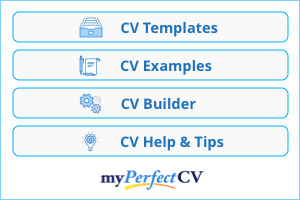
Email Cover Letter and CV | Sending Tips and Examples

What is an email cover letter?
An email cover letter is essentially a job application email through which you apply for a job. The email must contain your cover letter, either in the body of the email or as an attachment, and your CV as a separate attachment.
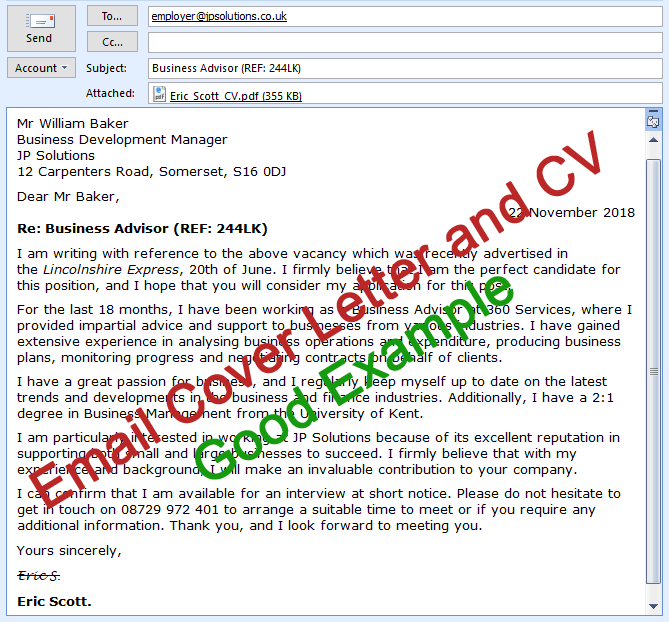
Do you need to send your CV and cover letter via Email?
With the massive technological boom over the past decade, we have seen the dramatic rise in email applications. Sending an email is free, it doesn’t require a stamp, visit the post office or a trip to the company you’re applying for. It all happens within seconds and with just one click of a button.
There are two main reasons why you would send an email to a recruiter:
- When you’re applying for a job
- When you’re enquiring about job opportunities at their company
In this guide, we will mainly focus on applying for jobs that have already been advertised . However, read on as there are also tons of tips and examples for those who wish to inquire about job opportunities via email.
The format of an email cover letter + template
The format of an email cover letter slightly varies from the format of a standard cover letter. For example, there is no need to include your personal details such as name and address on the right side of the letter because your attached CV will already contain all this information. Moreover, it will take up valuable space.
Your email to the recruiter should be in the following format:
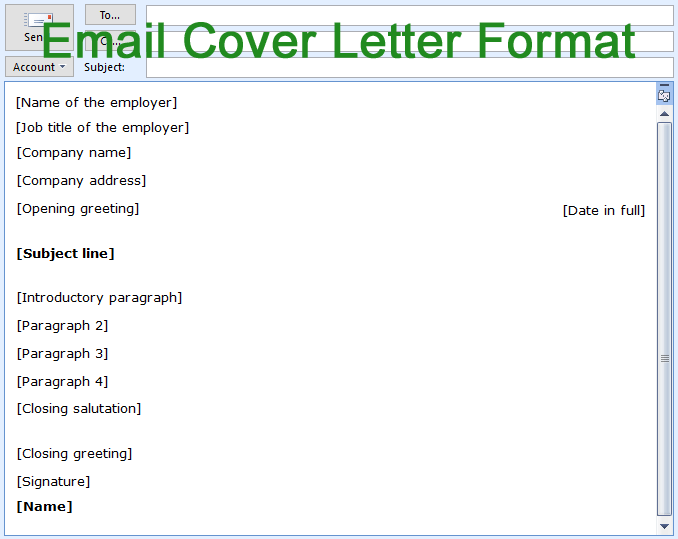
Click here to download this template.
Before you start…
1. Have your perfect CV and cover letter ready
Before working on drafting your email, make sure that you have already written and prepared your CV and cover letter. Check out How to write a Cover Letter and How to write a CV guides for more tips and examples.
2. Be formal
The job application process is a formal process. As such, you have to have a formal approach to writing your email job application.
- Don’t use contractions (e.g. I’m instead of ‘ I am ‘ or Let’s instead of ‘ Let us ‘)
- Write in complete sentences
- Write in paragraphs (not in short lines, as you would in text messaging)
- Use formal greeting (use ‘ Dear Sir/Madam ‘, ‘ Dear [Surname], ‘ or ‘ To whom it may concern ‘ rather than ‘ Hey ‘, ‘ Hi ‘, or ‘ What’s up? ‘)
- Don’t write in capitals (IT’S NOT NICE TO READ TEXT IN CAPITALS!)
You can find more information on formal writing here .
3. Use a professional email address
You must use a professional email address when contacting the recruiter.
It should be:
- It should be short in length
- It should contain your name
- It shouldn’t contain any/many numbers
Acceptable examples:
- [email protected]
Unacceptable examples:
4. Keep it short and to the point
You only have one chance to grab the attention of the prospective employer, so keep the letter short and to the point. Employers only tend to scan CVs and cover letters for less than a minute. Anything longer than a single side of A4 will most likely not be read or considered. Why take the chance? You will have plenty more opportunities in the later stages of the recruitment process, including during the job interview, to fully impress the prospective employer.
5. Write the content of the email in a separate document first
It is highly recommended to write your letter in a separate Word document first rather than typing it up on the actual email client in one go. This is because there will be a smaller chance of losing your work because of the loss of internet connection or the software crashing in the middle of writing your letter.
It also gives you additional time to properly check your written document for grammar and spelling mistakes.
How to send a cover letter and CV via email
Let’s get started…
1. Email subject line for job application
The subject of your email should be the job position followed by the job ID or job reference number:
- IT Manager (ID: W124)
- Receptionist (Job Ref. A2014)
- Cleaner (Job ID: AFT2421)
That’s all that is required.
If you decide to add anything extra, e.g. including your name or a short message, please keep it short as there is a limit on how much of the subject line will be shown to the recruiter when they receive it in their inbox.
Do not write your subject line in capital letters
Some applicants, in a desperate attempt to make their email stand out from the rest, write the subject line of their emails in capital letters, like this:
This is not recommended for two reasons:
- It is awful to read, and;
- You come over as either too desperate or too aggressive. In the worst case scenario, you come over as both.
QUESTION: Should you write the cover letter in the body of the email or send it as an attachment?
Some employers prefer attachments, whereas others prefer the letter in the body of the email. Please check for company requirements on the job advertisement. If the company has not specified their preference, it is up to you how you’d like to send your cover letter to them.
It’s decision time!
As previously stated, there are two acceptable ways of doing this:
1. Include the cover letter as an attached file
If you decide to attach your cover letter separately to the email, always write a short message in the body of the email introducing yourself and giving the reason for emailing the recruiter – don’t leave it blank! The content of your email body should be short, informative and to the point:
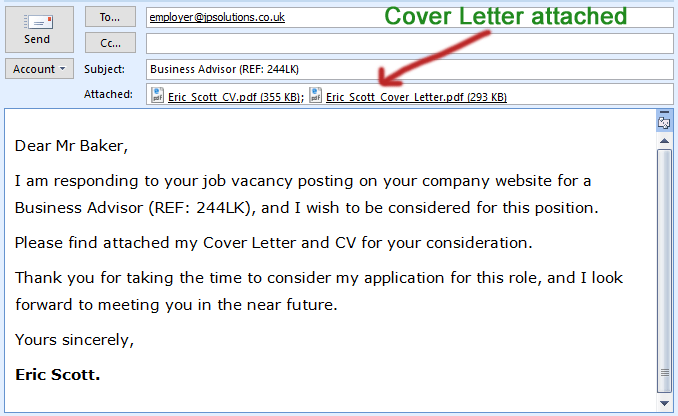
Another good example:
Please find attached my CV and Cover Letter for the position of Senior Research Fellow.
I look forward to hearing from you!
Kind regards, Michael Harper.
2. Write the cover letter in the body of the email
This is the most popular way of sending an email job application.
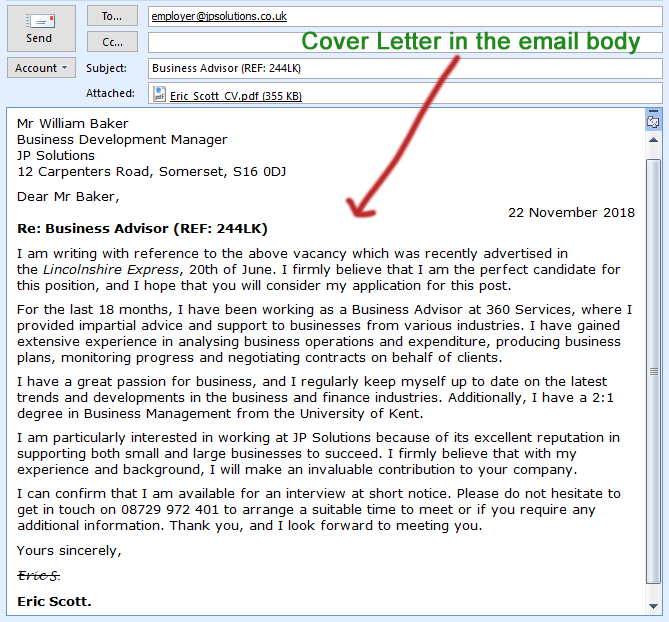
I can already hear you ask “which one is better?” glad you asked.
Our recommendation is to write the cover letter in the body of the email. It gives the opportunity to make a strong and memorable first impression, allowing you to grab the prospective employer’s attention within seconds.
If you send it as an attachment, on the other hand, the employer has to take the additional step of finding and opening your letter in order to read it. Some recruiters will not open attachments out of fear of infecting their computers by viruses.
Warning: Don’t include the same cover letter in the body of the email and as a file attachment. That is just a weird thing to do and makes you look very indecisive.
The remainder of the guide will show you step-by-step how to write your email covering letter in the body of the email:
How to start an email
2. employer’s personal details.
The first few lines of your letter should be the personal details of the recruiter:
- Recruiter’s full name
- Recruiter’s job title
- Company name
- Company address
Good example:

3. Opening salutation/greeting
The next line of your covering letter is the opening salutation, which should be written in the following format:
“Dear” followed by their honorific title (Mr, Mrs, etc.) and surname.
- Always use formal greeting (e.g. ‘ Dear Sir/Madam ‘, ‘ Dear [Surname] ‘ or ‘ To whom it may concern ‘ rather than ‘ Hey ‘, ‘ Hi ‘, or ‘ What’s up? ‘)
- It’s always best to find out the name of the employer to whom you are written the letter. This makes the letter more personal and convincing.
- If you’re addressing the employer by name, only include their surname (Dear Mr Kent) and not their full name (Dear Mr Simon Kent).

The next line should include today’s date in full ( 10 November, 2018 instead of 10/11/18 ), aligned to the right.
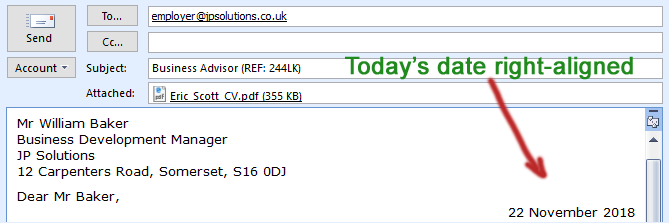
5. Introductory paragraph
State the reason why you are writing this covering letter.
For example:
I am writing to express my interest in the Electrical Engineer role listed in The Worcester News, 19th of March 2017. After carefully reviewing the job requirements, I feel I have all the necessary experience and technical skills to excel in this position, and I would wholly appreciate your consideration.
- These are the first few sentences that the prospective employer will be reading about you; make sure the introductory paragraph is short , to the point and is written for high impact .
6. Paragraph 2
In this paragraph, clearly outline the reasons why you would be a suitable candidate for this position. Make mention of your relevant education, qualifications, work experience, strengths, skills and abilities.
I graduated in 2014 with a first-class degree in Librarianship from the University of Essex, and I worked for a year as a Junior Librarian at Summerfield College. Both my education and work experience have given me a great insight into the purpose, function and processes of libraries. I am trained in all the standard library information and data management systems.
- Try to back up your statements with real-world examples. For instance, if you wrote that you have an “ excellent track record in sales “; back it up by tangible and verifiable performance information, e.g. by stating that you “ increased the company’s sales by 23% in six months. “
7. Paragraph 3
Following on from paragraph 2, expand on more reasons why you would be the ideal candidate for this job position.
I graduated in 2015 with a 2:1 degree in Business Management from the Queen’s University Belfast, something which kindled my passion for business and the economy. I studied a broad variety of topics ranging from Marketing Principles and Corporate Responsibilities to Leading Change and Strategic Management. I am a driven, ambitious and analytical individual with the excellent ability to analyse current business operations and offer meaningful solutions based on the findings.
8. Paragraph 4
This is going to be the final information-packed paragraph of your cover letter. Mention any other selling points that you have and state the reason why you are interested in working for this particular company.
I am especially attracted to joining your organisation because of the emphasis it puts on long-term growth and training within the company. Challenges motivate me, and I believe that I would be able to bring together my prior knowledge and skills as a competent Recruitment Officer. I am confident that my records of impressive accomplishments over the past few years prove that I will become a valuable asset to Lancefield Recruitment.
- Do research about the company you are applying for and use your findings to draft this paragraph. This will make you look interested, intelligent and resourceful in the eyes of the prospective employer.
How to end the email
9. closing statement.
The final paragraph is usually a polite call for action in which you state that you are looking forward to meeting the prospective employer. It must also contain a reference to your CV that you have attached with the application.
Useful phrases you can use:
- Please find attached my CV for your consideration.
- I have attached my CV with this email.
- For your consideration, my CV is attached with this email.

10. Closing salutation
The closing greeting should be “Yours sincerely” only if you addressed the employer by name (e.g. Dear Mrs Sanders) at the beginning of the letter.
If you used “Dear Sir/Madam” or “To whom it may concern” as the opening greeting of your letter, it should end with “Yours faithfully.”
Other alternatives that you may use instead of “Yours faithfully”:
- Best regards
- Kind regards
- Best Wishes
11. Signature & Sender’s name
Sign off the letter with a signature followed by your name.
If you do not have a scanned or electronic signature, you can write the signature in the following format:
- Email address
- Telephone number
- LinkedIn profile – optional

That is it – you should now have a perfectly written email cover letter!
- Don’t rush by writing and sending your email in one go – you will most likely forget to include important things or make many factual, grammatical or spelling mistakes. Write a draft version first, take a break, and then come back again in a few hours time to review it.
- Don’t forget to attach your files ! You only have one chance to make a good impression, make sure you don’t mess it up with clumsy mistakes.
- Send a test email to yourself first to double-check the email’s format and whether attachments can be opened.
- Give the attachments identifiable file names, for example, “ Julia_McCaree_CV.pdf ” is better than “ newhkh34.pdf “
Shall I send my documents in Word (.doc or .docx) or PDF format? Both methods are acceptable. However, we recommend you send it as a PDF file because that will preserve the format and presentation of your documents; including margins, padding, spacing and indentation.
How do I find out if my job application email has been received? Unfortunately, you can’t be sure whether the employer has opened or read your email unless they tell you so. Some email clients allow you to ask for a “Read” receipt after the sender has opened your email. However, you will only receive a “Read” receipt if the recipient decides to send you one.
After how many days shall I follow-up my application? Most job vacancies will state the timeframe in which you should hear back from them if you have been shortlisted for an interview. Many job vacancies will state: “If you do not hear back from us within 2 weeks time, please assume that your application has been unsuccessful this time.” If, however, this is not specified you should get in touch with them after a week to follow-up on your initial application.
Should I use the “ high importance ” flag when sending my application? No, not really. The high importance flag has lost its value years ago. Besides, there is a chance that you will come across as rude as why should your job application email be more important or urgent than those of other senders? More than 90% of emails are sent without one.
Working on your CV? Awesome!
- References on a CV (Examples + 2024 Complete Guide)
- Blank CV Template
- The Best Data Entry CV Example [2024 Guide + Tips]
- Good CV Examples & Templates for 100+ jobs
Over 15,000 amazing people have connected with us - and you're amazing too!
Copyright © 2024 CV Plaza All Rights Reserved
Privacy Overview
12 CV cover letter examples
A cover letter for your CV, or covering note is an introductory message that accompanies your CV when applying for a job.
The purpose of the cover letter is simple… Persuade the reader to open your CV.
Learn how to write a cover letter properly, and you will hugely increase your chances of getting responses and landing job interviews.
This guide, with 12 annotated cover letter examples will show you everything you need to know about creating a winning cover note.
CV templates
How to layout a cover letter for your CV
This annotated example of a cover letter shows you how you should structure your cover letters, and the type of information you should be including.
You should always write your CV in the body of your email (or j ob site messaging system) so that it can be read instantly. Never attach it as a separate document, or the recipient probably won’t open it.

Example CV cover letters
These 11 example CV cover letters from a range of industries should give you some good inspiration for creating your own cover letter.
Admin CV cover letter
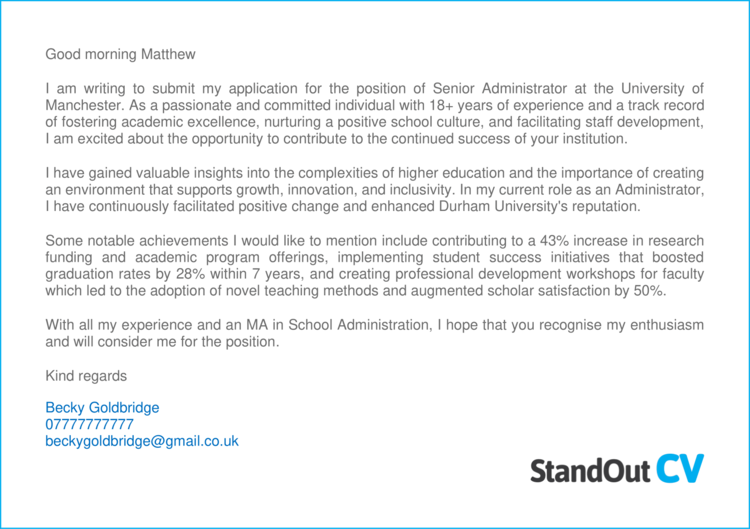
This cover letter is aimed at administrative roles , so it highlights the candidate’s abilities in efficiency, report writing and meeting deadlines, whilst demonstrating the types of environments they have worked in.
Learn how to write a cover letter step-by-step here.
Customer service CV cover letter
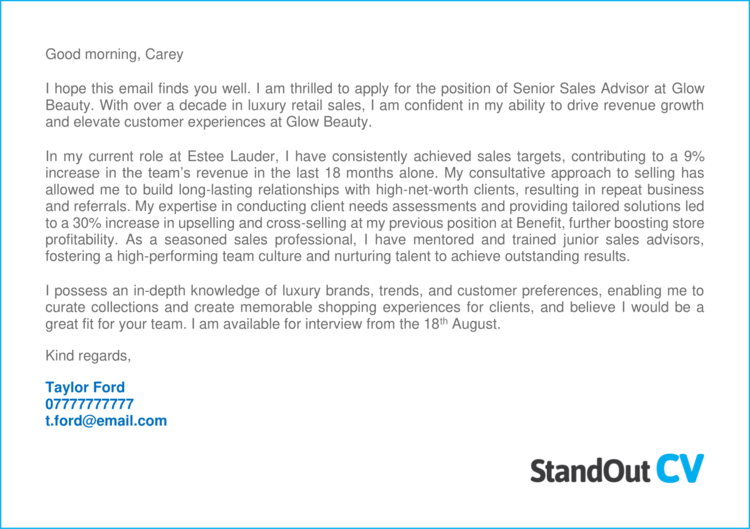
This customer service cover letter briefly explains the candidate’s length of experience in the field and highlights some of the more important customer service skills such as call handling, order taking and complaint resolution.
This gives the reader an excellent introduction to the candidate and should certainly encourage them to open the CV.
See our full customer service cover letter guide, sales assistant cover letter example and waiter/waitress cover letter example .
Finance CV cover letter
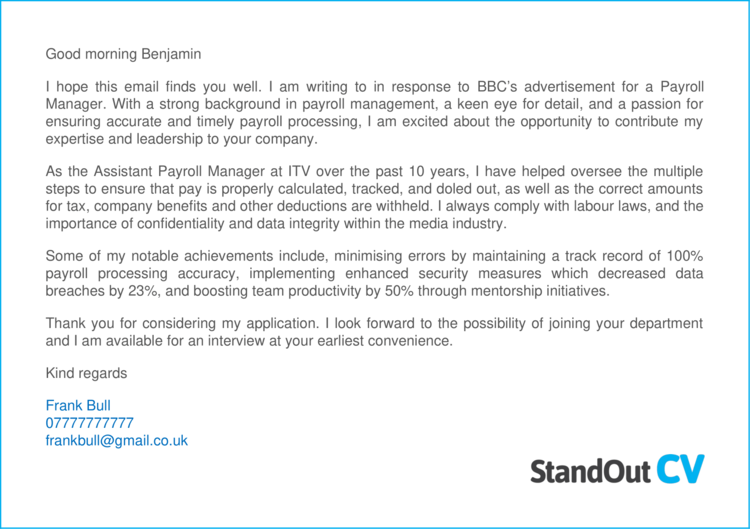
As a finance professional, it’s important to highlight your specialisms within finance, the types of companies you’ve worked for, and high level functions you’ve carried out within your cover letter. This will give the hiring manager a good overall feel of your abilities, and if it’s well tailored to the role, should provide them with enough info to excite them about your CV.
Quick tip: Use our job application tracker spreadsheet to track your applications and follow up with employers who don’t respond.
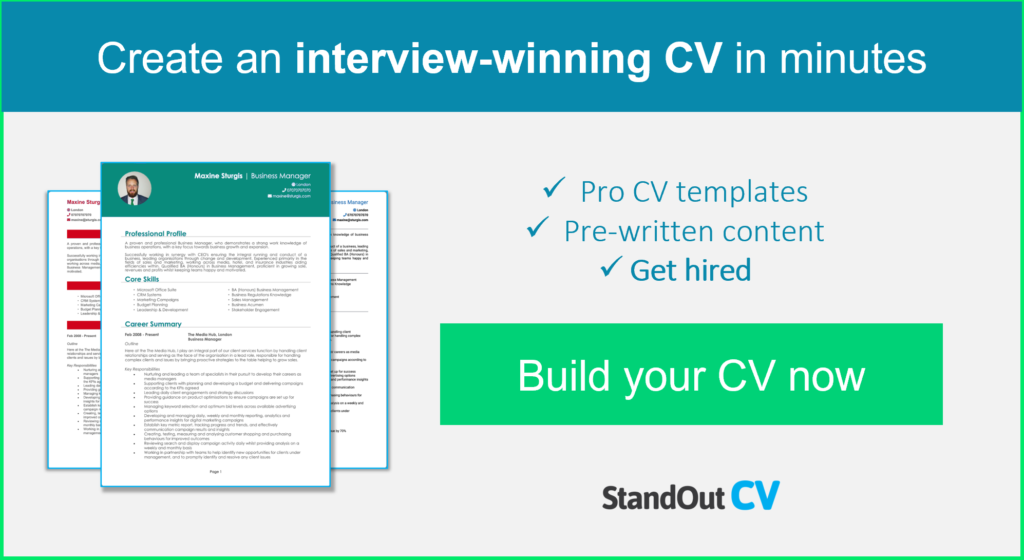
Events CV cover letter
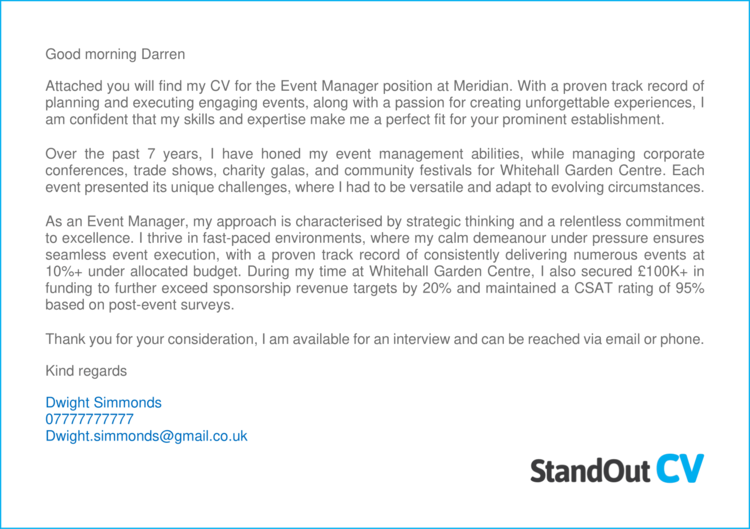
This events manager candidate has done a great job of summarising the type and size of events they manage, along with details of core skills such as leadership, project delivery and stakeholder management.
This certainly provides enough info to create a buzz around the CV attached and encourage the recipient to open it.
Executive assistant CV cover letter
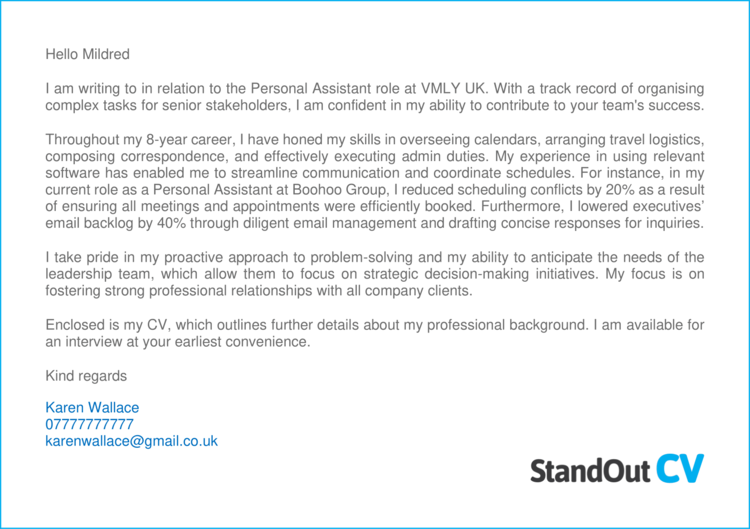
This executive assistant CV cover letter provides a good high level intro to the candidate showing the reader key business support knowledge in areas such as admin, diary management and document management. It also shows that the candidate is confident supporting senior business figures.
Graduate CV cover letter
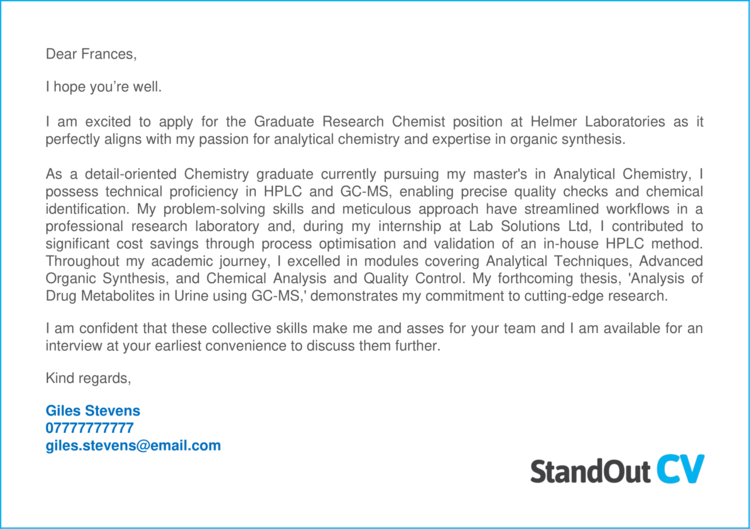
As a graduate , your cover letter will need to be a little longer than an experienced candidates, to compensate for your lack of experience and really sell yourself.
This candidate speaks in lots of detail about their education, qualifications, and extra-curricular work which relates to the roles they are applying for.
IT CV cover letter
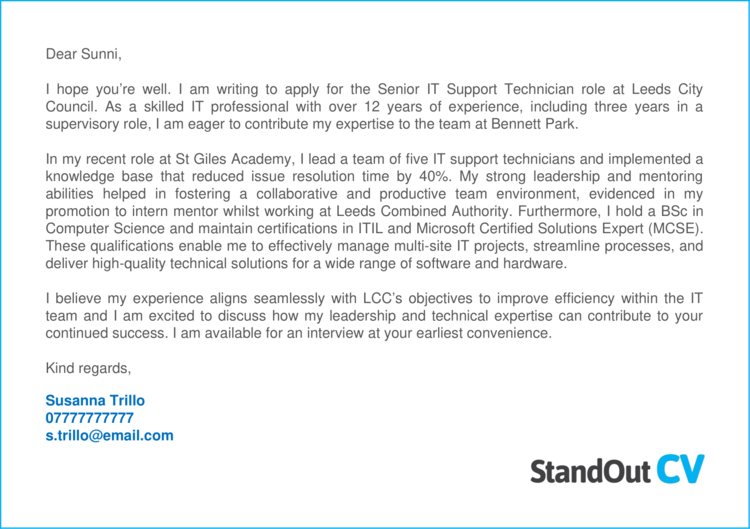
As an IT candidate, it’s important not only to highlight your technical skills, but also show how you apply those skills in the workplace to translate real benefits for your employer.
This candidate gives a good overview of the candidates technical abilities and the types of projects they apply them to, along with results they achieve.
Marketing CV cover letter
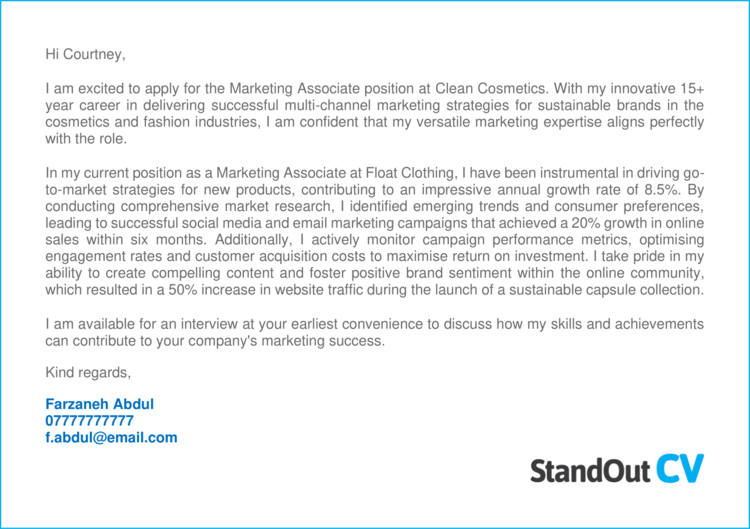
This marketing cover letter provides readers with a summary of the candidate’s core marketing abilities such as media planning, brand awareness and cost reduction. It also explains the types of marketing campaigns and companies they have experience with – a great high-level intro.
Cover letter examples
Warehouse Operative cover letter – Training Contract cover letter – Cleaning Job cover letter – Nursery Assistant cover letter – Recruitment Consultant cover letter – Dental Nurse cover letter –
Chef cover letter – Editorial Assistant cover letter – Aircraft Mechanic cover letter – Biomedical Science cover letter – Cabin Crew cover letter – Finance Assistant cover letter – Hotel Receptionist cover letter – Asset Management cover letter – Assistant Psychologist cover letter – Beauty Therapist cover letter – Cafe Worker cover letter – HR Administrator cover letter – NQT cover letter – Quantity Surveyor cover letter
More cover letter examples
- Academic cover letter
- Account Manager cover letter
- Accountant cover letter
- Accounting cover letter
- Accounts Assistant cover letter
- Acting cover letter
- Admin Assistant cover letter
- Administrator cover letter
- Apprenticeship cover letter
- Architecture cover letter
- Assistant Manager cover letter
- Banking cover letter
- Bar Staff cover letter
- Barclays cover letter
- Barista cover letter
- Bartender cover letter
- Business Analyst cover letter
- Business Development Manager cover letter
- Car Sales Person cover letter
- Care Assistant cover letter
- Career Change cover letter
- Catering Assistant cover letter
- Civil Engineer cover letter
- Computer Science cover letter
- Consulting cover letter
- Copywriter cover letter
- Cyber Security cover letter
- Data Entry Clerk cover letter
- Data Scientist cover letter
- Delivery Driver cover letter
- Digital Marketing cover letter
- Electrician cover letter
- Engineering cover letter
- Estate Agent cover letter
- Event Manager cover letter
- Exam Invigilator cover letter
- Executive Assistant cover letter
- Fashion Designer cover letter
- Finance cover letter
- Financial Analyst cover letter
- Google cover letter
- Graduate cover letter
- Graduate Engineer cover letter
- Graduate Scheme cover letter
- Graphic Design cover letter
- Health Care Assistant cover letter
- Hospitality cover letter
- HR Assistant cover letter
- HR cover letter
- Interior Designer cover letter
- Internal Position cover letter
- Internship cover letter
- Investment Banking cover letter
- Investment Manager cover letter
- IT Support cover letter
- Journalist cover letter
- JP Morgan cover letter
- Lawyer cover letter
- Legal Assistant cover letter
- Legal cover letter
- Library Assistant cover letter
- Manager cover letter
- Marine Engineer cover letter
- Marketing Assistant cover letter
- Marketing cover letter
- Marketing Intern cover letter
- Marketing Manager cover letter
- McKinsey cover letter
- Mechanical Engineer cover letter
- Medical Receptionist cover letter
- Medical Writer cover letter
- Model cover letter
- Nanny cover letter
- Nurse cover letter
- Nursing cover letter
- Office Assistant cover letter
- Office Manager cover letter
- Operations Manager cover letter
- Optical Assistant cover letter
- Paralegal cover letter
- Part Time cover letter
- PE Teacher cover letter
- Personal Assistant cover letter
- Personal Trainer cover letter
- Pharmacist cover letter
- Pharmacy Assistant cover letter
- PHD Application cover letter
- Photographer cover letter
- Placement cover letter
- Private Equity cover letter
- Product Manager cover letter
- Production Assistant cover letter
- Production Operator cover letter
- Project Coordinator cover letter
- Promotion cover letter
- PWC cover letter
- Quantity Surveyor cover letter
- Receptionist cover letter
- Research Assistant cover letter
- Researcher cover letter
- Retail Assistant cover letter
- Retail cover letter
- Retail Manager cover letter
- Sales Advisor cover letter
- Sales Executive cover letter
- Sales Manager cover letter
- Scrum Master cover letter
- Security Officer cover letter
- Ski Season cover letter
- Social Media Executive cover letter
- Social Media Manager cover letter
- Software Developer cover letter
- Software Engineer cover letter
- Speculative cover letter
- Student cover letter
- Support Worker cover letter
- Teaching Assistant cover letter
- Team Leader cover letter
- Trainee Dental Nurse cover letter
- University cover letter
- UX Designer cover letter
- Volunteer cover letter
Project manager CV cover letter

A project manager’ s cover letter needs to quickly explain to recipients the types of projects they lead and the technical expertise they bring to the projects. It’s also important to describe level of experience, seniority and background.
See full project manager cover letter example + writing guide
Operations manager cover letter
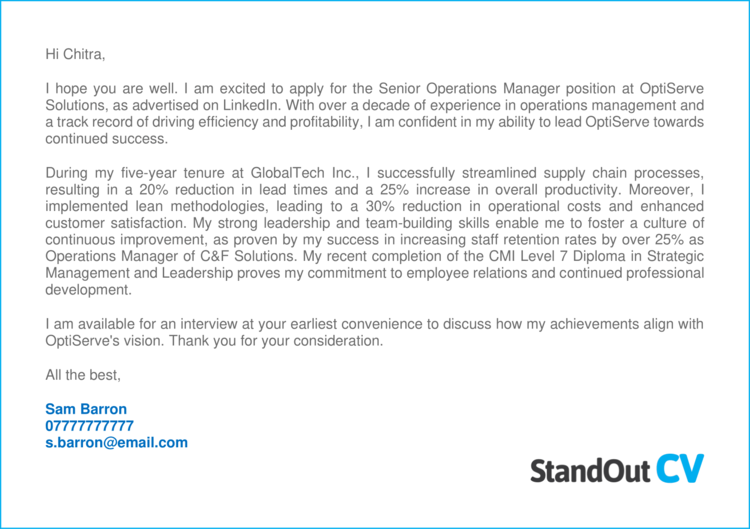
This operations management CV provides a brief introduction to the types of operations the candidate manages and the firms they work for.
They also touch upon some core operations skills such as efficiency, logistics and ROI improvement.
Sales CV cover letter
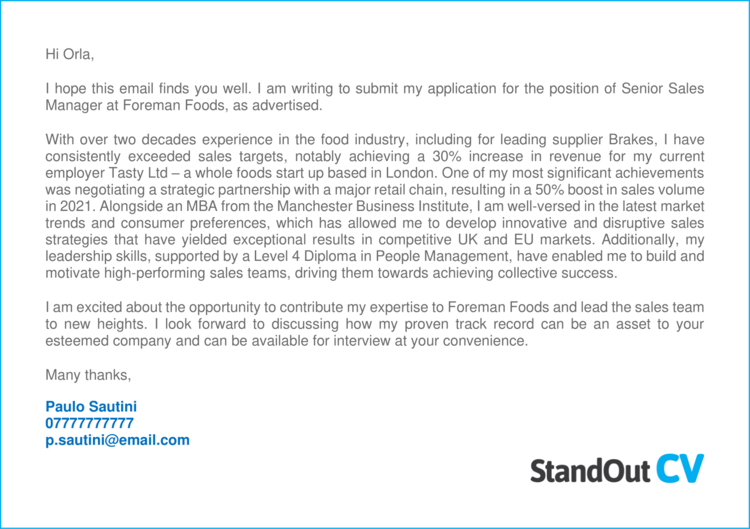
As a sales candidate, this cover letter shows the types of business this person can generate and the size and scale of the impact they create by highlighting some sales results.
It also mentions some core sales skills like business development, presenting, working under pressure and closing deals.
Cover letter templates
Teacher cover letter
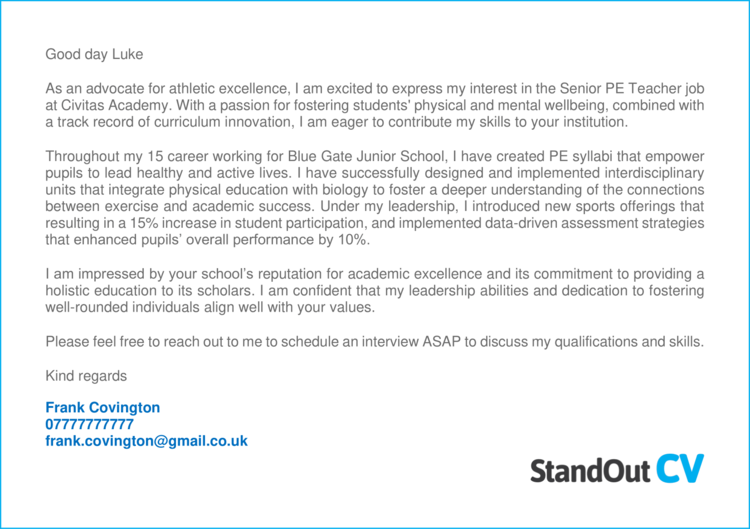
This teacher cover letter does a great job of introducing the candidate, and showing the recipient the key facts they will be looking for, such as; the age group they teach, subject specialisms, and the results they have achieved.
The cover letter is brief and gets to the point quickly, so that readers will instantly look to open the attached CV .
How to write your CV cover letter
Now that you’ve seem good examples of cover letters to accompany your CV (or resume if you are in the USA) this guide will show exactly how to write your own, and the content that needs to be included .
Send your CV cover letter in email format (when possible)
When applying for jobs online you usually have 2 choices…
1) Send a message via the job website’s messaging system
2) Send the recruiter an email directly
If you can find an email address for the recruiter, then I would always recommend sending an email directly because it gives you more control.
When you send a message through a job website, it will transfer into an email with basic formatting and an auto-generated headline , which will look like this when the recruiter receives it.

If you cannot find an email address for the recruiter on the job advert, then try searching LinkedIn or the company website to find the relevant contact.
You may not always be able to find an email address, but when you can – always send a job application by email .
Make your subject line appealing
As you can see in the picture above, a bad subject line can kill your chances of actually having your email read in the first place.
Your subject line should stand out and give the recruiter a reason to open your email.
When recruiters look into their inbox, they are looking for one thing; a candidate who can do the job they are advertising – so give that to them in your subject line.
Your subject line should be a short summary of your experience that relates directly to the job you are applying for.
The following are good subject line examples;
KS2 Teacher with 5 years experience
Front End Web developer with HTML, HTML & JavaScript experience
Junior Graphic designer with 1st BA Hons Graphic Design
If your subject line shows that you have one or two of the most important requirements for the job, your email should get opened every time.
Address the recruiter by name

To get the relationship off on the right foot, you should try to address the recruiter by name if you can.
Often the recruiter’s details will appear on the job advert but sometimes you may have to check out the company website or do some digging around on LinkedIn.
If you really can’t find the name, then it’s not the end of the world – just start with a simple friendly opening like “ Hi ”
(If you applying to a more traditional organisation such as an academic post for a university, you may want to use something a bit more formal like “ Dear sir or madam ”)
Use a friendly yet professional tone
It’s important to sound professional when writing a cover letter but you also need to demonstrate your ability to communicate with other people and show some personality.
If your email is too casual and written in an over-familiar tone, then you will come across us un-professional.
But on the other hand, if your email is too formal and shows no signs of rapport building, you risk appearing as somebody who lacks social skills.
So when writing your cover letter, try to strike a nice balance of professionalism and friendliness.
Opening with a line such as “ hope you’re well ” is a nice way to breathe a bit of personality into your cover letter.
Ensure that your spelling and grammar is perfect throughout your cover letter because sloppy mistakes are a huge red flag for recruiters.
Quick tip: If you struggle with spelling and grammar, try our quick-and-easy CV Builder
Keep it brief
Unless the job advert specifies otherwise; keep your cover letter short and sweet.
Recruiters and employers receive hundreds of job applications per week, so they don’t want to read a 2 page cover letter.
Depending on the role, around 2-4 sentences should be enough for the content of the cover letter.
You just need to write enough to persuade them to open your CV – It should roughly contain the same amount of information as your CV profile or personal statement.
Show how your skills match the job
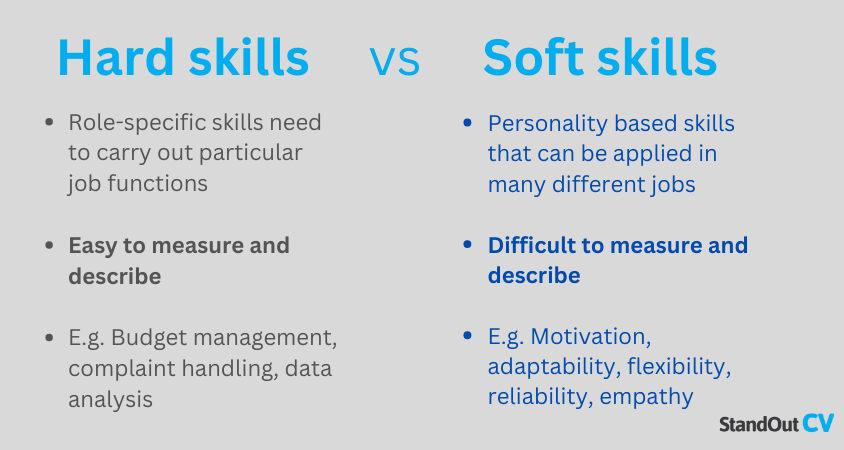
To ensure that recruiters open your CV, you simply need to explain how your skills and experience match the job requirements from the advert.
Scan the job advert to discover what the most important candidate abilities are, and show how your previous experience has prepared you to cover these.
In particular, look out for any requirements that are essential to the job .
Focus on what you have to offer at this stage and not what you want.
At this stage, your covering letter is simply a means of getting the recruiter to open your CV, so it’s too early to talk about salary demands etc. Save that for your initial conversation with the recruiter.
Include a professional signature

End your cover letter with a friendly salutation such as “Regards” and a smart signature which includes your name and most direct contact method (usually mobile phone for most people)
A professional email signature will show recruiters that you understand business-email etiquette and ensure they have a means of contacting you – even if they can’t open your CV for any reason.
Writing a CV cover letter
Hopefully this guide has given you everything you need to create a winning cover letter that will ensure you CV gets opened every time you send it.
Just remember to keep it brief, be friendly, tailor it towards your target role, and give recruiters some good reasons to be interested in you.
Good luck with the job hunt!
How to Send a Cover Letter Email

You only get one chance to make a first impression which is why your cover letter email is so important. Emailing a cover letter is your chance to show why you’re the best candidate for the job and to demonstrate that you’re a professional who is serious about the application.
The email cover letter should provide information on your expertise, such as your qualifications, skills, and experience as well as the reasons why you’re applying for the role. You need to show the employer why you’re a good fit for the position and to grab their attention so they look at your resume.
Candidates are often too quick to send an email cover letter . This is a mistake. It is worth spending some time focusing on each aspect of the cover letter to ensure it’s up to scratch. In a competitive job market, marginal gains are everything.
Your professional resume is still the most powerful tool you have at your disposal when you’re job hunting and using a resume builder is an effective way of nailing it. Your cover letter needs to work in tandem with your resume.
How to send an email cover letter
One of the most important pieces of cover letter advice is to always follow the employer’s instructions . Failure to follow basic instructions during the application process gives the wrong impression. It seems sloppy and unprofessional.
Sending an email cover letter and resume as attachments
If the instructions in the job posting say to include your cover letter as an attachment , then do so. Either include it as a Word document or as a PDF . As you’ll include both your resume and cover letter it’s important to clearly name both files (e.g. petergreencover.pdf and petergreenresume.pdf).
Sending an email cover letter as the main email
If the job posting instructions don’t state whether to include your cover letter as an attachment , it is best to copy and paste your cover letter and include it as the main email, with just your resume attached. This way, when an employer double clicks on your application email, they will instantly see your attention-grabbing cover letter .
How to write a an email cover letter for a job application
A professional cover letter should follow a clear cover letter format . It should start with a header, an opening paragraph (why you’re applying), a second main paragraph (why you’re the best candidate), a closing paragraph (thank them for their time and state what’s attached), and an electronic signature.
Before you start writing it, you should carefully read through the job posting and identify the key job requirements . You should then analyze your own expertise and be ready to show how your skill set matches the job . Each cover letter should be tailored for each application.
You should choose some examples of when you’ve demonstrated each key requirement and include them in your cover letter. This is much more convincing than just saying you’re innovative, creative, or dynamic.
Don’t send a boring cover letter that starts with:
“My name is Maria Smith and this cover letter is intended to express my interest in the Finance Manager position as listed on Glassdoor. I believe my background in technology companies and finance experience makes me an ideal candidate for this role.”
Use the introduction to capture the attention of the reader . You can use a sentence showing that you’re aware of their company and why you’re interested in them specifically and to briefly introduce your value proposition.
In the second paragraph , explain why you’re the perfect fit. Ask yourself the following questions:
- What are some programs/initiatives you worked on that have had a big impact?
- Did you get promoted fast?
- What skills do you have that match the requirements of the job?
- Did you save time or made money for your organization?
In the last paragraph , you can tell the hiring person that you’d love to be considered for the role.
Cover letter email example
Get more cover letter examples advice in our guide with tips and information about all aspects of a good cover letter structure.
Subject: Customer Services Position: Jane Cooper
Dear Ms. Wilson,
I would like to express my interest in the position of Customer Service Representative which is advertised on LinkedIn. I believe that my four years of experience in customer services and my positive attitude make me the ideal candidate for this position.
I am used to working in a target-driven environment and have surpassed my personal targets for three consecutive years. I have also won two ‘Passion Awards’ for my approach towards delivering excellent customer service. My strong communication skills, which have been recognized through consistent positive feedback from our customers.
Thank you for taking the time to consider my application. Please find a copy of my resume attached. I look forward to having the chance to discuss what I can bring to the role in more detail.
Sincerely yours,
Jane Cooper

Write your cover letter
Introduce yourself to the recruiters using one of our professional templates.
Related Blog


How to Create a Compelling Cover Letter in Microsoft Word
E very time you apply for a job, it's a good idea to include a cover letter. Deciding how to write each one is hard, but at least you don’t have to start from scratch with their design.
Microsoft Word offers templates and welcomes third-party designs to help you create compelling cover letters. Here’s how to use such options in Word and make the best first impression possible to potential employers.
Use Microsoft Word’s Cover Letter Templates
Formal letters don’t have to be bland. Go to File > More templates on Word, and type “cover letter” in the search box. You’ll find several stylish designs that add structure and color to your document.
What reflects you better, a subtle or sharp color scheme? If you’re considering a bold header for your professional details, learn how to design letterheads on Word , too. You can even add your portrait to your cover letter.
Microsoft Word’s built-in templates also include fields for you to fill in with your information and that of your potential employer. They guide you in these small ways, some even providing a sample for your letter’s main body. It’s a good idea to rephrase that, though, to fit each job application.
If you don’t like any of the options on Word’s desktop app, explore more Microsoft cover letter templates online and download your favorites from there.
Use Third-Party Templates in Microsoft Word
You can create cover letters for your dream job on platforms besides Microsoft. If you’d rather stick with it, you’ll even come across third-party templates specifically designed for you to download and customize on Word. Here are some examples.
1. ResumeLab
Explore over 50 cover letter templates, ranging from minimalist to eye-catching designs. Keep in mind that a few of them are meant to be created on ResumeLab. The rest you can bring onto Word by clicking their Download it free here link.
You’ll be redirected to websites like Good Resume and Resume Genius , which help you quickly download your documents. Then, all you have to do is open them in Microsoft Word.
You’ll also notice that some cover letters on ResumeLab are edited versions of Word’s built-in templates, but this just adds to your selection and gives you more ideas.
2. Template.net
This is a popular site for templates of all kinds, including cover letters. For some designs, you pay a small fee, but Template.net has an impressive range of free options, too. What’s more, the download process is very easy.
Just browse its collection, click on a design you like, and select the Word button under Download Free Template . In the next window, hit Free Download . If you’re not signed in already, you’ll be asked to as the final step.
Follow Best Practices for Cover Letters
Familiarize yourself with the dos and don’ts of writing a cover letter . Remember these guidelines when selecting and customizing a template or crafting a cover letter from scratch. They boil down to the following rules.
1. Research Potential Employers
Do your research before writing or designing your cover letter. Get to know each company and even the recruiter you’re addressing. It’s the same strategy as tailoring your resume for different job types .
2. Tailor Your Cover Letter
When showcasing your skills and interest in a position, use your research to tailor your letter so that it grabs the recruiter’s attention and impresses them. Be smart, enthusiastic, and concise with your words.
3. Use Your Blank Space Wisely
Aim to limit your cover letter to one page. Any more than that, and you risk losing the recruiter’s interest. Think about what you need to say, including important and relevant details not covered in your resume. Express these things as succinctly as possible.
4. Your Visuals Should Complement and Not Overwhelm the Letter
Add a bit of color and texture, going for a subtle effect. You could even use some small icons, as long as they’re tasteful and discreet. Whatever you choose, keep these visuals on the letter’s edges, and don’t let them dominate the text.
5. Master Word’s Features That Benefit Cover Letters
For example, you can create your cover letter more efficiently by setting the text’s boundaries from the get-go. To do this, go to Layout > Margins . From the same toolbar, you can adjust paragraph spacing and indentation.
Through Insert > Pictures , you can import an image of your signature and place it at the end of the letter. Your header and footer can be customized from here, too.
Even the Mailing toolbar might be of interest. It can help streamline the process of writing and sending letters, as well as keeping track of recipients.
Good Planning and Wording Make the Best Cover Letters
Between Microsoft and other providers, you have access to a wide selection of templates for simple but attractive cover letters that you can personalize on Word. The app itself is full of useful writing and editing tools.
With this leg up, designing a cover letter for every occasion is easier. Sound research and planning in terms of how to approach each application can help polish the letter even more.

Official websites use .gov A .gov website belongs to an official government organization in the United States.
Secure .gov websites use HTTPS A lock ( A locked padlock ) or https:// means you've safely connected to the .gov website. Share sensitive information only on official, secure websites.
- Create Account
Expedite Requests
ALERT: If you are a healthcare worker or a childcare worker
If you are a healthcare worker or a childcare worker
- Who has a pending Form I-765, Application for Employment Authorization, initial application, which has been pending for over 90 days; OR
- Who has a pending Form I-765, Application for Employment Authorization, renewal application and whose Employment Authorization Document (EAD) expires within 30 days or less, or has already expired:
Call the USCIS Contact Center at 800-375-5283 (TTY 800-767-1833) to request expedited processing based on your position as a healthcare worker or a childcare worker with an EAD application that meets the above criteria.
To determine whether you are a qualifying healthcare worker, see this DHS advisory memorandum (“Healthcare/Public Health” section, pages 7-9) (PDF) .
To determine whether you are a qualifying childcare worker, see the Standard Occupational Classification (SOC) code 39-9011, which includes workers who “attend to children at schools, businesses, private households, and childcare institutions” and “perform a variety of tasks, such as dressing, feeding, bathing, and overseeing play.” (Note that this definition does not include preschool teachers or teaching assistants.)
Be prepared to provide evidence of your profession or current or immediate prospective employment as a healthcare worker or a childcare worker and current valid immigration status. If the evidence you provide is not sufficient, we may not accommodate your request for expedited processing of your Form I-765.
You may request that USCIS expedite the adjudication of an application, petition, request, appeal, or motion that is under USCIS jurisdiction.
We consider all expedite requests on a case-by-case basis and generally require documentation to support such requests. The decision to expedite is within the sole discretion of USCIS. Expediting your case generally means that we would adjudicate your benefit ahead of others, including those who may have filed earlier, so we carefully weigh the urgency and merit of each expedite request.
Relevant criteria or circumstances that may be considered in determining whether to grant an expedite request include, but are not limited to, the below:
- Severe financial loss to a company or person, provided that the need for urgent action is not the result of the petitioner’s or applicant’s failure to timely file the benefit request or to timely respond to any requests for evidence;
- Emergencies or urgent humanitarian situations;
- Nonprofit organization (as designated by the Internal Revenue Service (IRS)) whose request is in furtherance of the cultural or social interests of the United States;
- Government interests, including cases identified by the government as urgent because they involve the public interest, public safety, national interest, or national security interests; and
- Clear USCIS error.
Not every circumstance that fits under the criteria or examples above will result in expedited processing. See more information below on expedite criteria and circumstances. For USCIS’ expedite policy guidance , see Volume 1 of the USCIS Policy Manual.
Note: The processes and requirements for requesting expedited adjudication are different for some application types and circumstances. Refer to the chart in the Specific Procedures section of this page for more information about expedite requests related to:
- Appeals or motions
- Refugee status
- Petition for refugee/asylee relative
- Humanitarian parole
- T nonimmigrant status
- U nonimmigrant status
- Other benefit requests pending with offices outside the United States
A company can demonstrate that it would suffer a severe financial loss if it is at risk of failing, losing a critical contract, or required to lay off other employees.
Job loss may be sufficient to establish severe financial loss for a person, depending on the individual circumstances. The need to obtain employment authorization, standing alone, without evidence of other compelling factors, does not warrant expedited treatment.
Examples may include:
- A medical office that may suffer severe financial loss if a gap in a doctor’s employment authorization would require the medical practice to lay off its medical assistants.
- A person who would lose critical public benefits or services.
In the context of an expedite request, an emergency or urgent humanitarian situation is a pressing or critical circumstance related to human welfare. Human welfare means issues related to the well-being of a person or group. Examples include, but are not limited to, illness, disability, death of a family member or close friend, or extreme living conditions, such as those caused by natural catastrophes or armed conflict.
NOTE: Certain benefit requests, such as asylum applications, refugee applications, and requests for humanitarian parole, by their nature involve urgent humanitarian situations. Therefore, filing a humanitarian-based benefit, standing alone, without evidence of other time-sensitive or compelling factors, generally may not warrant expedited treatment under this criterion.
Examples of emergencies or urgent humanitarian situations may include:
- A vulnerable person whose safety may be otherwise compromised.
- Healthcare workers who are needed during a pandemic.
Travel-Related Requests
USCIS considers expedited processing of an Application for Travel Document ( Form I-131 ) when there is a pressing or critical need for an applicant to travel outside the United States.
Expedited processing of a travel document may be warranted when there is an unexpected need to travel outside the United States for an unplanned event, such as for a funeral. Expedited processing of a travel document may also be warranted when there is a pressing or critical need to travel outside the United States for a planned event, but processing times prevent USCIS from issuing the travel document by the planned date of departure. When there is a request to expedite processing of a travel document for a planned event, we will consider whether the applicant timely filed Form I-131 or timely responded to a request for evidence.
NOTE: A benefit requestor’s desire to travel solely for vacation generally does not meet the definition of a pressing or critical need to travel.
We generally require documentation to support an expedite request. Examples of evidence that may support travel-related expedite requests are outlined in the following table.
Examples of a pressing or critical need to travel outside the United States may include:
- A requestor who has a pressing or critical need to travel outside the United States to obtain medical treatment in a limited amount of time.
- A requestor who has a pressing or critical need to travel outside the United States due to the death or grave illness of a family member or close friend.
- A requestor who applied for a travel document 5 months ago when they learned of the event, but their case remains pending, and they must travel for a pressing or critical professional, academic, or personal commitment, which is now in 45 days.
A nonprofit organization seeking to expedite a beneficiary’s benefit request must demonstrate an urgent need to expedite the case based on the beneficiary’s specific role within the nonprofit in furthering cultural or social interests (as opposed to the organization’s role in furthering social or cultural interests).
- A professional who is urgently needed for research related to a specific U.S. social interest.
- A university professor urgently needed to participate in a specific and imminent cultural program.
- A religious organization that urgently needs a beneficiary’s specific services and skill set to continue a vital social outreach program.
This includes cases identified as urgent by a federal, state, tribal, territorial, or local government of the United States because they involve public interest, public safety, national interest, or national security interests. The request must be made by a person who has authority to represent the agency or department, such as an official, manager, supervisor, or tribal leader, on the matter for which expedited treatment is being requested. The request must demonstrate that the interests are pressing and substantive.
Where a federal agency or department is able to state a federal government interest in accordance with these criteria, we generally defer to that federal agency or department’s assessment.
If the request relates to employment authorization, the request must demonstrate that the need for the applicant to be authorized to work is critical to the mission of the requesting agency or department, and goes beyond a general need to retain a particular worker or person.
- A noncitizen victim or witness who is cooperating with a federal, state, or local agency and needs employment authorization because the respective agency is seeking back pay or reinstatement in court proceedings.
- A noncitizen scientist whose contributions are needed by a government lab or grantee.
USCIS may consider an expedite request based on clear USCIS error when a requestor establishes an urgent need to correct the error.
An example may include:
- An applicant who receives an Employment Authorization Document with incorrect information that prevents them from being able to work may request a replacement document on an expedited basis if we caused the error.
You generally may request we expedite your case after you receive a receipt notice. (The process to request an expedite is different in some circumstances. See the Specific Procedures section below.)
Before submitting an expedite request, you should:
- Check current case processing times to determine whether you need an expedite.
- Check your case status online . If there is an action on your case pending with you, such as submitting biometrics or evidence, you should complete these actions before submitting an expedite request.
- Check whether premium processing service is available. We will not consider expedite requests for petitions and applications where premium processing service is available, unless the petitioner is designated as a nonprofit organization by the IRS and filing for a beneficiary whose services are needed to further the cultural or social interests of the United States.
Please make only one expedite request to reduce duplicate efforts and help us use our resources for quicker processing. Multiple requests may delay USCIS’s ability to expedite processing.
Expedite Requests for Travel Documents
If you are requesting expedited processing of a travel document , you generally need to apply for and obtain the document before you leave the United States. You should make your expedite request on your pending application at least 45 days before you plan to leave the United States. (If you must travel within the next 15 days, see the Emergency Travel page.)
For most cases, you may request an expedite by contacting the USCIS Contact Center or by asking Emma. (You can access Emma by clicking on the Ask Emma icon on the top right of this page). You need to explain why you need expedited processing. You also generally need to provide your receipt number to the USCIS Contact Center so they can send your request to the office that has your application or petition. If you have a USCIS online account and have access to secure messaging, you may select “expedite” as the reason for your inquiry and submit your request there.
You generally need to justify your expedite request with evidence. When communicating with the Contact Center, you will be asked about supporting documentation. You should be prepared to supply this to the office processing your case.
If you have a USCIS online account , you should upload evidence through your online account to support your expedite request in addition to calling the USCIS Contact Center. If you send a secure message, we will ask you to confirm that you have uploaded evidence in your account. If we receive an expedite request without evidence to support it, we will send you instructions on how to submit the evidence.
Note: The processes and requirements to request expedited adjudication are different in some circumstances. Refer to the chart under Specific Procedures below for expedite requests related to:
- Appeals/Motions
Some programs and circumstances have their own processes and requirements for requesting expedited adjudication and may have different expedite criteria. You should follow the specific procedures referenced below for requesting an expedite in the following circumstances:
We receive a large number of expedite requests. We generally send a response to expedite requests that are submitted through the Contact Center. However, to increase efficiency in processing expedite requests, we generally do not provide justification for expedite decisions.
A decision on an expedite request is not an approval or a denial of your underlying benefit request. The expedite decision simply determines whether we will take your benefit request out of order and try to issue a decision (approval or denial) faster than the normal processing time. We cannot make a decision on your benefit request until all processing requirements have been completed.
Some circumstances may prolong or inhibit our ability to expedite certain benefit requests. Examples include, but are not limited to, when:
- The benefit requestor must perform a certain action or submit additional documentation or evidence related to their benefit request, such as attend a biometric services appointment, be interviewed, or complete any required immigration medical examination ;
- There is a required background check that remains pending with a third-party agency;
- An application or petition requires an on-site inspection; or
- An application or petition depends on the adjudication of a principal’s application or petition.

IMAGES
VIDEO
COMMENTS
3. Open a new document. To begin combining your resume and cover letter into a single document, start a new file on your computer in your preferred application or platform. Choose a file name that's professional and use your full name without any numbers to differentiate your application from the candidate pool.
Create a new document. Make sure that you create an entirely new document for your combined file. That will enable you to keep them separate for other companies and submissions. Then copy and paste your resume and cover letter into this new document. Be sure to save the file with an appropriate file name.
Open the 2 doc files. <CTL A> to select all text in one document, the <CTL C> to copy it. go to second document. <CTL END> to jump to the end of the doc. <CTL V> to paste the copied document. you now have 2 of the documents in one. save as the combined document to a new name as a "DOC" format file.
Click on Insert > Attach File. Your email client will display a list of files in the default file folder of your computer. If your resume and cover letter are stored in a different folder, click on the appropriate folder. Click to select the file you want to add to your email message, and then click on Insert to attach the document to your ...
Place your name, city, state, ZIP code, phone number and email address in your cover letter heading. Your email address should be professional like "[email protected]," and not personal like "[email protected]." Include links to your LinkedIn profile or professional online portfolio if you have one.
How to write a CV cover letter. You can use the following process to write an effective CV cover letter: 1. Identify the requirements for the position. Read the job description well and identify employer expectations in relation to academic achievements, education, skills, and experience. Make a list of these expectations.
There are two email formats which you can use to include your cover letter. You can either copy and paste it into the main body of the email, or include it as a PDF or Word document. If you send the resume cover email as an attachment, you still need to write an email for attaching the resume. Write a formal email stating why you are applying ...
A professional cover letter is a one-page document you submit alongside your CV or resume as part of a job application. Typically, they're about half a page or around 150-300 words. An effective cover letter doesn't just rehash your CV; it's your chance to highlight your proudest moments, explain why you want the job, and state plainly ...
Sign off professionally. Finish your cover letter with a friendly term such as, "kind regards" followed by your name. Then add a professional signature to the bottom, like the one below; This makes the cover letter look professional and ensures that recruiters have; Your full name. Phone number. Email address.
Step 9: Stay Formal in the Closing Salutation. Once you've written the body of your cover letter, you just need to put a formal closing at the very end. Write "Sincerely" and follow it with your full name. Adding your handwritten signature is optional (recommended for more formal cover letters).
Header - Input contact information. Greeting the hiring manager. Opening paragraph - Grab the reader's attention with 2-3 of your top achievements. Second paragraph - Explain why you're the perfect candidate for the job. Third paragraph - Explain why you're a good match for the company.
6. Attach your cover letter to the email. To attach your cover letter, create a new email message in your email program and choose the paperclip icon. Browse through the files on your computer to find your cover letter and click to attach it to the email. 7.
A cover letter is a one-page document you send with your resume that features additional information about skills and experiences related to the job you're seeking. It is typically three to four short paragraphs. In these paragraphs, you should meet these goals: Mention the role you want by name.
Middle paragraph (s) Closing paragraph. Letter ending and signature. Your cover letter should be one page long and use a simple, professional font, such as Arial or Helvetica, 10 to 12 points in size. Your letter should be left-aligned with single spacing and one-inch margins. Show Transcript.
1. Have your perfect CV and cover letter ready. Before working on drafting your email, make sure that you have already written and prepared your CV and cover letter. Check out How to write a Cover Letter and How to write a CV guides for more tips and examples. 2. Be formal. The job application process is a formal process.
Executive assistant CV cover letter. This executive assistant CV cover letter provides a good high level intro to the candidate showing the reader key business support knowledge in areas such as admin, diary management and document management. It also shows that the candidate is confident supporting senior business figures.
Greet the recipient by name in the email and inform them who you are and why you're sending them your CV. Close the email politely and give your full name. Use the 'attach' button in your email's interface to select and upload your CV document and cover letter. Check everything is in order before sending.
There are 3 types of cover letters that you can send to a hiring manager. The 3 types are: Application cover letters. Letters of Interest. Email Cover letters. The letter you write is influenced by whether you are going to apply for a job directly, citing a referral, or asking about vacancies that are not advertised.
Typically, a cover letter should not be more than 1-page long (the average time for hiring managers to read one resume is less than 20 seconds!), and within this 1 page, you should include the following 5 parts: contact information, greeting, hook, body, closing. Let's dig into each of them!
If the instructions in the job posting say to include your cover letter as an attachment, then do so. Either include it as a Word document or as a PDF. As you'll include both your resume and cover letter it's important to clearly name both files (e.g. petergreencover.pdf and petergreenresume.pdf). Sending an email cover letter as the main email
The format of a cover letter should follow the structure of any persuasive argument: the introduction sets the scene; the body of the cover letter contains the key arguments; and the conclusion ends on a high note and includes a call to action.
If you're providing a hard copy of your cover letter, handwrite your signature and also include your full typed name. Download Cover Letter Outline Template. To upload the template into Google Docs, go to File > Open > and select the correct downloaded file. Related: Creating the Perfect Cover Letter (With Template and Example)
3. Use Your Blank Space Wisely. Aim to limit your cover letter to one page. Any more than that, and you risk losing the recruiter's interest. Think about what you need to say, including ...
From the drafted cover letter, copy and paste the content into the body of the email. Remove dates and contact information and check to see the pasted text has aligned correctly. 9. Include an email signature. Most email services have a function that allows you to automatically include a signature.
An application letter is a document similar to a cover letter or a resume that job seekers submit when they are interested in a role.. The document is similar to a cover letter, and it should follow business letter formatting.. Before writing an application letter, you should research the company and read the job ad to find out which skills and qualifications are needed.
Consider these three elements when naming your resume or cover letter file: 1. Start the file name with your full first and last name. Use your professional name—especially if you go by a nickname while away from the office or around coworkers who know you well—to make a positive first impression. 2. Follow your name with a summary of the ...
Expedite Requests for Travel Documents. If you are requesting expedited processing of a travel document, you generally need to apply for and obtain the document before you leave the United States. You should make your expedite request on your pending application at least 45 days before you plan to leave the United States.